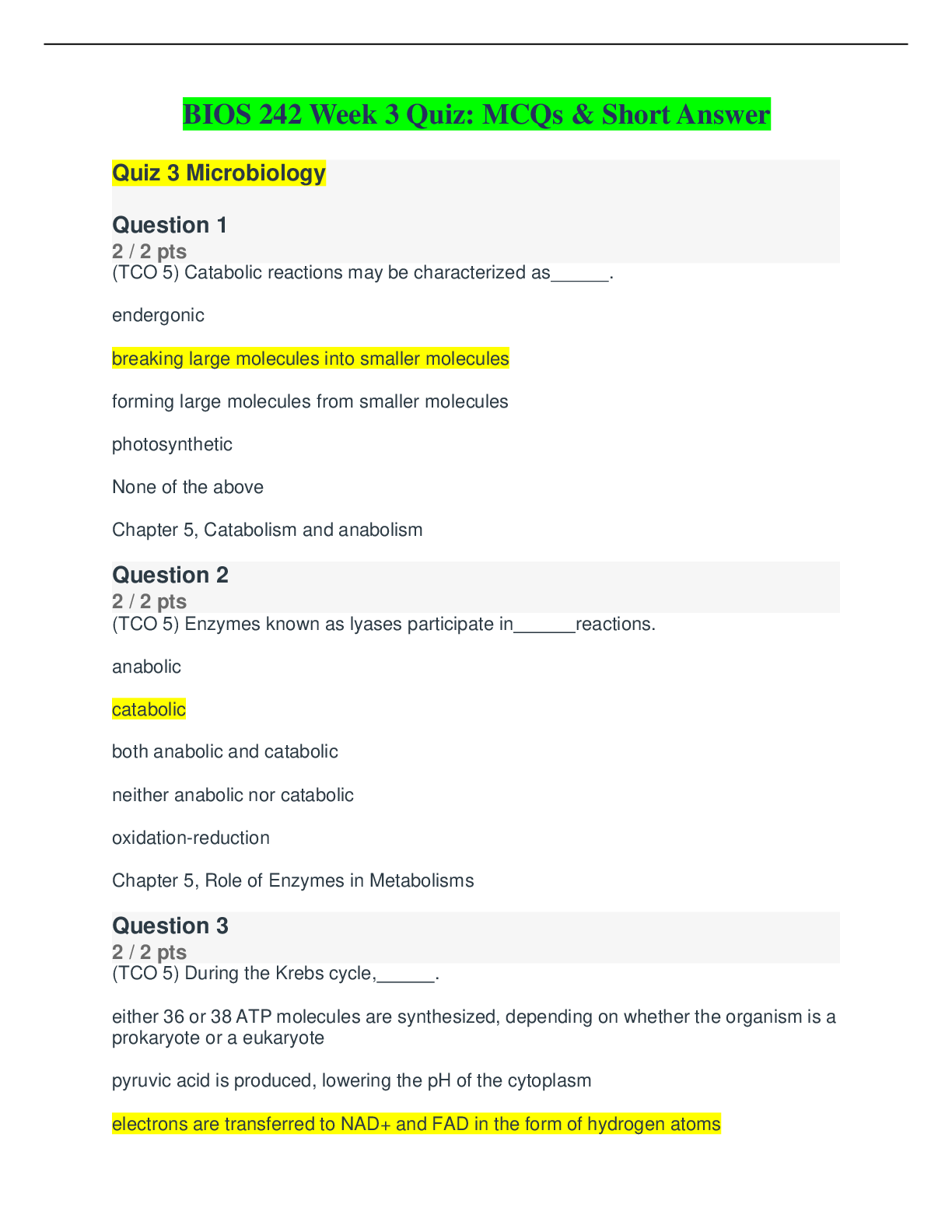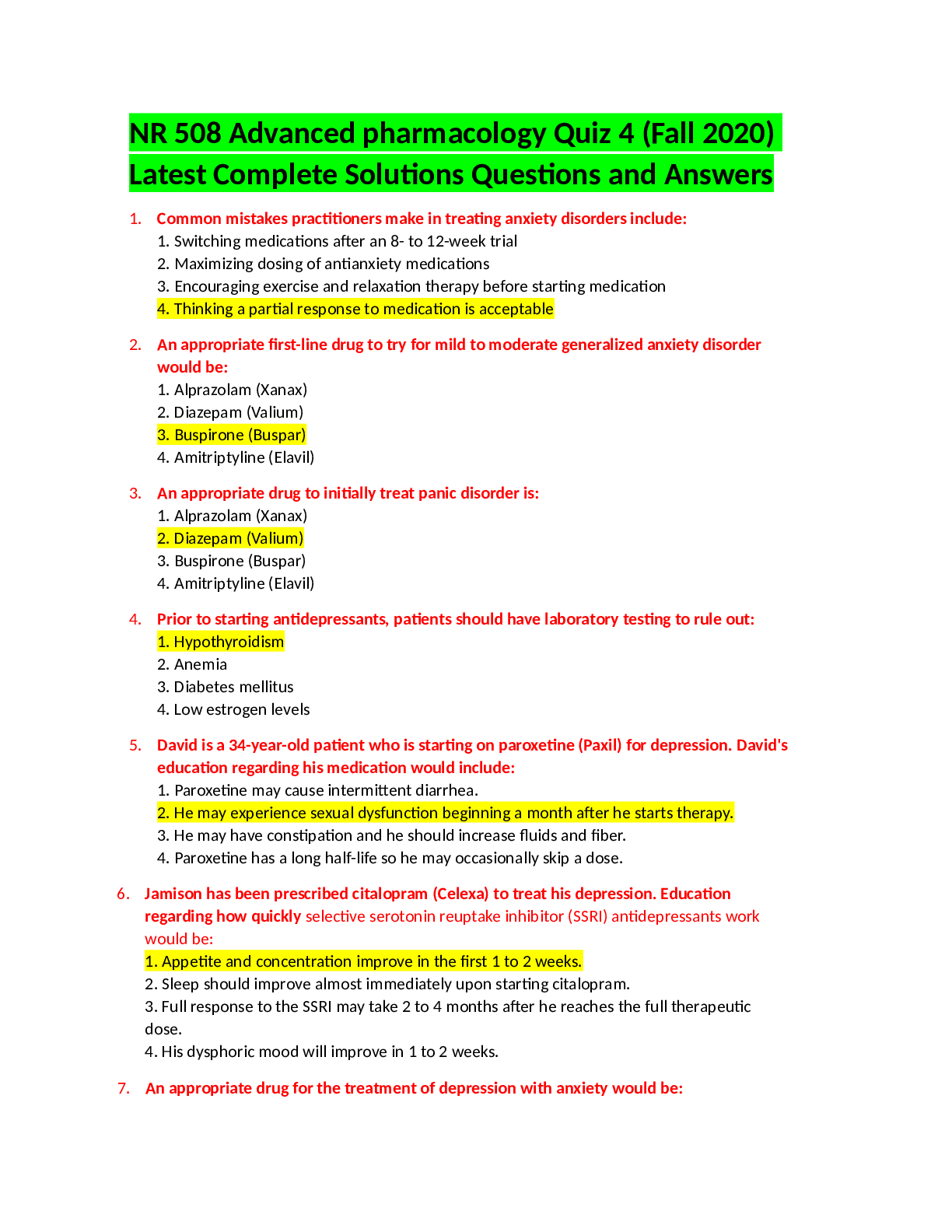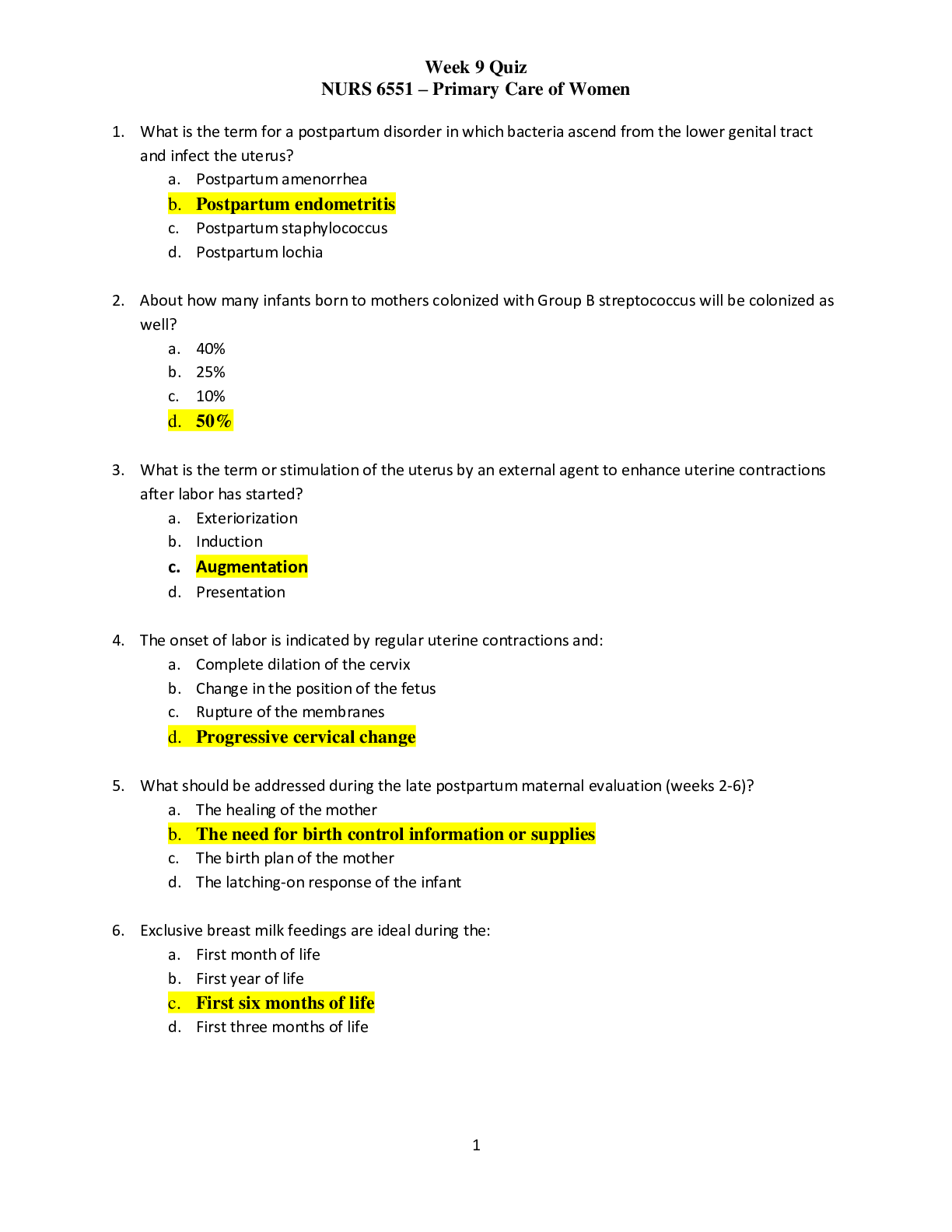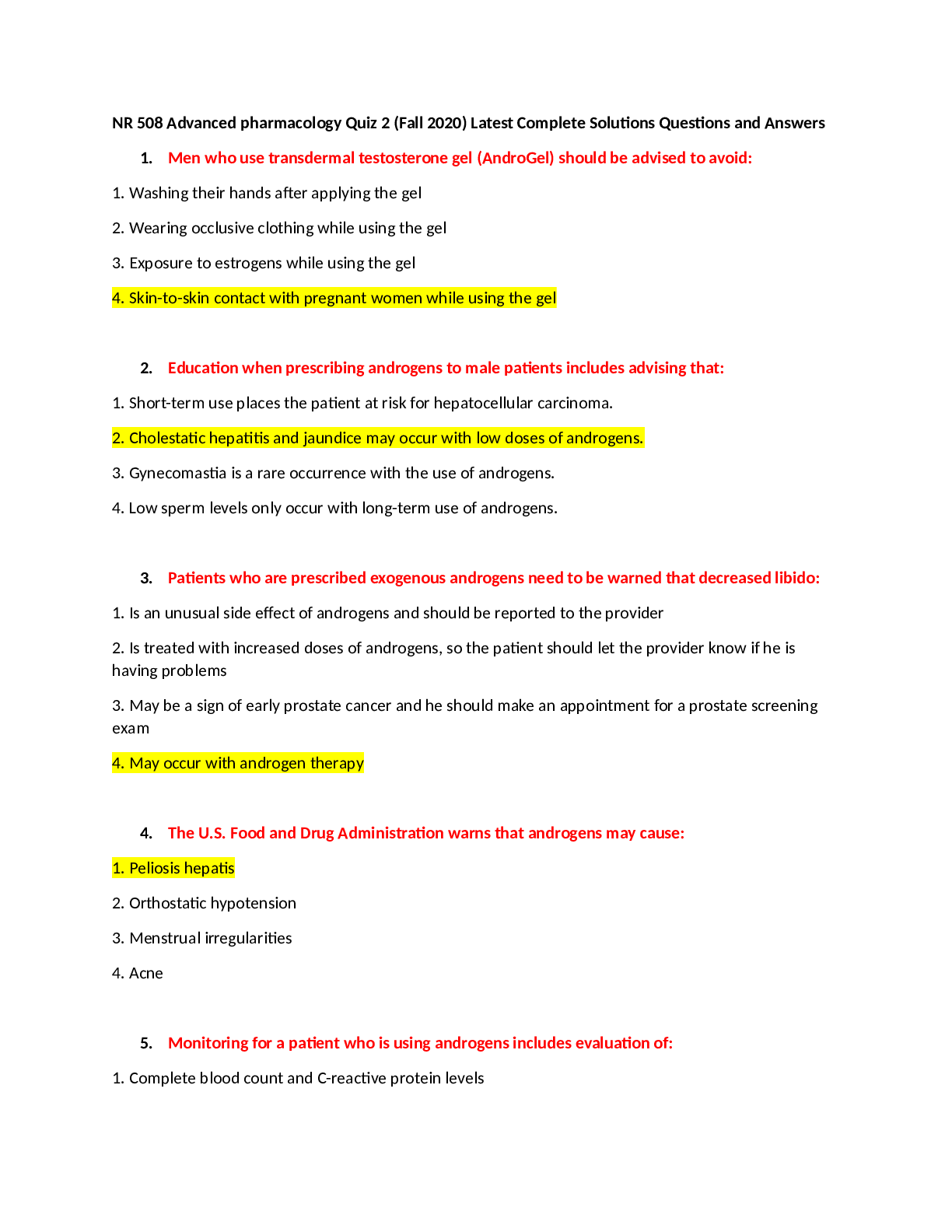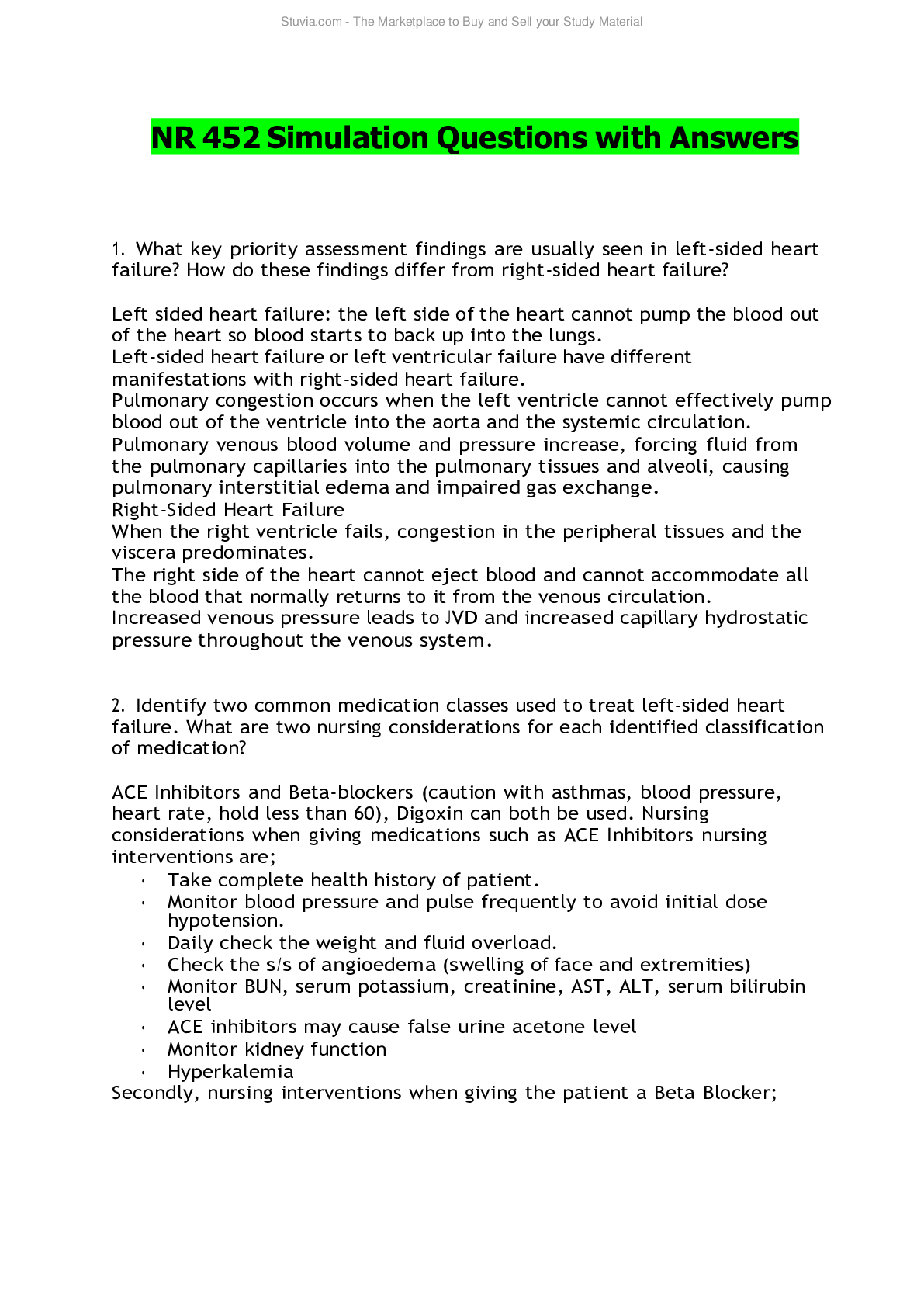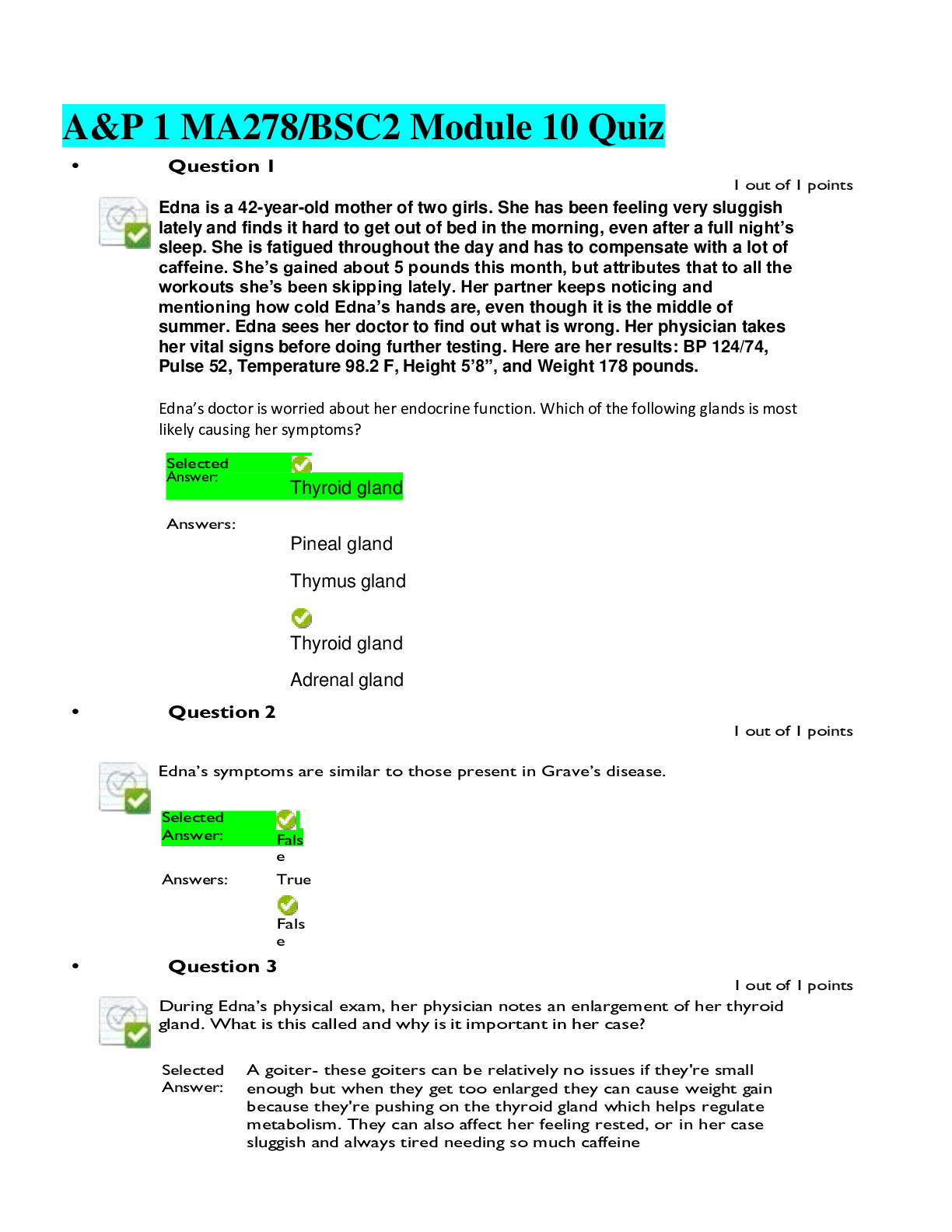Statistics > QUESTIONS & ANSWERS > GLOBUS QUIZ 1 ANSWERS PART 1 QUIZ BANK LATEST COMPLETE SOLUTION (answered) A graded. (All)
GLOBUS QUIZ 1 ANSWERS PART 1 QUIZ BANK LATEST COMPLETE SOLUTION (answered) A graded.
Document Content and Description Below
GLOBUS QUIZ 1 ANSWERS PART 1 QUIZ BANK 1. A camera-maker's price competitiveness in a particular geographic region is determined by whether the average wholesale price it camera retailers for its c... amera models is within $20 of the regional average wholesale price; all companies with average wholesale prices within $20 of the regional average wholesale price are considered to be price competitive. All other companies are considered to be charging average wholesale prices that are NOT price competitive. whether the average wholesale price for its camera models is within 10% of the lowestpriced camera brand in the region: a company becomes progressively less price competitive the greater its average wholesale price is more than 10% above the company with the lowest average wholesale price. how favorably the average wholesale price it is charging camera retailers for its models compares to the lowest average wholesale price being charged by a rival camera-maker in that same geographic region. how much its average wholesale price to camera retailers in the region is above or below the regional average wholesale price. whether the average wholesale price it is charging camera retailers for its models is at least 10% below the highest-priced camera brand in the region: all companies whose average wholesale price is more than 10% below the highest-priced camera brand in the region are considered to be price competitive . 2. Which of the following does NOT accurately describe your company's camera/drone business and operations? The company has two buildings for assembling products at its Taiwan site--one for cameras and one for drones (the drone assembly process also includes assembly of an actioncamera model having features and specifications suitable for use in camera-equipped drones). No camera models or drone models are assembled in advance, warehoused in company facilities, and then used to fill incoming orders.The unmanned aerial view (UAV) drones assembled at the Taiwan plant are sold directly to buyers at the company's website and to other online retailers of commercial drones in each geographic region. The company makes the majority of the needed camera components at facilities close to its Taiwan assembly plant; newly-produced camera components are transferred by truck on a just-in-time basis to the company's camera assembly facilities where the company operates a 250-person assembly line capable of turning out 3,250 cameras per hour. There is ample space at the camera assembly facility to add two more 250- person assembly lines should they be needed later to fill incoming buyer orders. Your company maintains regional facilities in Milan, Italy: Singapore; Sao Paulo. Brazil: and Dallas. Texas to handle the company's marketing efforts in each of the world's principal geographic regions, to support the merchandising efforts of area retailers who stock the company's brand of action-capture cameras and UAV drones, and to process camera/drone warranty claims (including making needed repairs) originating in their respective geographic regions. Once the company's action-capture cameras are assembled and tested. the company ships them across the world to multi-store chains and online retailers that sell electronics products and to a wide variety of local retail shops stocking and merchandising (or sometimes renting) action-capture cameras to their customers. 3. The benefits of current and cumulative expenditures for camera/drone product R&D do NOT include which of the following? Providing a pipeline of tested ways to add more features, improve product performance. and build the company's proficiencies in introducing new and improved camera/drone designs and models Reducing the costs of camera/drone parts, components, accessories. and enhancement features; the size of this benefit varies according to the amount spent Boosting a company's P/Q ratings (the size of this benefit varies with the current and cumulative amounts spent and shows up in the P/Q ratings at the beginning of the following year) Reducing annual maintenance costs for installed camera/drone workstations (this benefit show up at the beginning of the following year) Increasing the productivity of PATs in assembling camera/drone models (because of easier toassemble product designs); the size of this benefit occurs immediately and varies according to the amount spent 4. Which one of the following is NOT a factor in determining a company's action camera sales and market share in a particular geographic region? The number of camera models in each company's line-up of camera offerings, the length of the warranty period for each company's camera models. and the amount companies spend for advertising. How a company's average wholesale price for the camera models it sells to retailers in the region compares with the average wholesale prices of the camera models of competing companies The extent to which the number of week-long camera sales promotions a company has annually is above/below the region's all-company average The amounts by which the company's credit rating and customer service rating are above/below the regional average Whether the size of the discounts off the regular average wholesale price a company offers to retailers during weekly sales promotion campaigns is above/below the regional average 5. Which of the following are components of the compensation package for members of camera/drone PATs? Annual base wage, assembly quality incentives ($ per unit assembled divided equally among PAT members), year-end bonus for perfect attendance, and the dollar-cost of a PAT member's fringe benefit package Weekly salary, the cost of a PAT member's fringe benefits package, weekly bonuses for meeting or beating the PAT's weekly assembly quota. overtime pay, and a monthly allowance for living expenses The hourly wage paid each PAT member (which can differ for camera PATs and drone PATs i. the costs of a PAT member's fringe benefit package, overtime pay, and a weekly allowance for cost of living expenses the daily wage paid to each PAT member, the costs of company-paid fringe benefits. a bonus of $4.00 per camera/drone assembled by each camera/drone PAT (which is subject to change), and a weekly allowance for living costsMonthly salary. the cost of a PAT's fringe benefits package, year-end awards of 10 shares of common stock for perfect attendance. weekly bonuses for meeting or beating the PAT's weekly assembly quota, and a monthly allowance for living expenses 6. Which of the following currencies are NOT involved in affecting the revenues your company receives on shipments of action-cameras and UAV drones to buyers in the four geographic regions where it competes? U.S. dollars and euros The Brazilian real and Taiwan dollars U.S. dollars and Taiwan dollars The Japanese yen and the Mexican peso Singapore dollars and euros 7. The Global Community Bank. under terms of its long-term banking agreement with the company, has agreed to lend the company additional monies should you elect to use debt to help finance growth and other financial needs; the interest rate the GCB will charge on such loans is determined is tied to the payback period (1-year, 5-years, 10-years) and to the company's debt-assets ratio and gross profit margin. the company's net profit margin. 4 the company's credit rating and the going rates of interest in world financial markets, how many consecutive years the company has been profitable and its interest coverage ratio. the company's balance sheet strength. 8. The factors that affect the productivity of both camera PATs and drone PATs include perfect attendance bonuses, the percentage use of overtime. the percentage of newlyhired PATs, and how well total compensation levels (not including overtime pay) for camera/drone PATs compare against the camera/drone all-company averages. the amount of overtime pay that camera/drone PAT members receive, warranty claim rates, camera/drone P/C) ratings. and how the total compensation packages (not including overtime pay) of PAT members compare to the all-company average compensation levels.the warranty claim rate. the amount of overtime pay each PAT member receives, the total number of cameras/drones that have to be assembled each year. the amount a company spends annually per camera/drone PAT on training and productivity-enhancing assembly methods, and the number of camera/drone components that PAT members have to assemble. the size of assembly quality incentives paid to camera/drone PATs, how favorably the overall size of a company's total compensation package (not including overtime pay) per camera/drone PAT member compares against the camera/drone all-company averages, and changes in the number of camera/drone models that have to be assembled. the complexity of the camera/drone designs. the size of the weekly bonuses paid to PAT members for exceeding the weekly assembly quota, the number of different models that have to be assembled, and the number of components that are used in assembling each camera/drone. 9. Worldwide unit sales of wearable, miniature action-capture cameras are reliably projected to grow 20% annually for Years 6-10, and then slow gradually to 10% annually by Year15. • 6-8% annually during Years 6-10 and then to grow at a slower 4-6% annuai rate during the following five years (Years 11-15). at rates that increase 1% each year, starting from 6% in Year 6 and rising to 15% by Year 15. at 10-12% annually during the Year 6-Year 10 period and at 7-9% annually during the Year 11-Year 15 period at annual rates slowly declining from 15% in Year 6 down to 5% in Year 15. 10. Which of the following are the four geographic regions in which the company is currently selling its action cameras and UAV drones? The United States, Western Europe, Australia-New Zealand. and Southeast Asia Europe-Africa, Latin America, Asia-Pacific, and North America Western Europe. Asia, North America. and South America Latin America. the European Union, China. and North America The European Union. North America, Southeast Asia. and Latin America 11. Which of the following is NOT included among the five measures on which a company'sperformance is judged/scored? Earnings per share Revenues and customer satisfaction Latest stock price Credit rating and ROE Image rating 12. The factors that affect the P/Q rating of a company's action cameras include the percentage of the action cameras that it sells which are outsourced from contract assemblers in Taiwan or mainland China. the prices it pays suppliers of materials and components used in its action-capture cameras and the quality ratings of these materials and components. the average wholesale price it charges camera retailers for its models, the quality and durability of the camera housing, and the number of extra performance features designed into its cameras. image sensor size, the size of the LCD display screen, the image quality of the videos and still pictures, and the number of photo modes for videos and still pictures. the size of assembly quality incentives it pays to camera PAT members, warranty claim rates, and the age of camera assembly workstations. 13. The company has its camera and drone assembly facilities in China. Japan. Brazil. Mexico. Taiwan. 14. Which of the following statements about your company's assembly operations for cameras and drones is false? The capital costs of new workstations and facilities expansions are paid in full in the year they occur. Cameras are assembled by 4-person PATs, while drones are assembled by 5-person PATs due to the added number of components and more complicated assembly methods. All of the company's capital expenditures for fixed assets (facilities, workstations. robotics upgrades, office equipment, and furnishings) at the Taiwan plant site are depreciated over 20 years at the rate of 5% annually.The manufacturers of robots have recently developed small robots capable of performing some of the tasks/work steps in assembling both action cameras and UAV drones: installing one of these robots at each camera/drone workstation enables the size of PATs to be cut by one person. The maximum number of cameras/drones that can be assembled at overtime is 20% of the number of cameras/drones that a camera/drone PAT assembles each year. 15. Which of the following statements about crafting a strategy to be competitively successful in the markets for action cameras and drones is true? The strategy and competitive approach that most frequently produces good-to-excellent overall company performance involves striving to be exceptionally cost efficient and pursuing a competitive advantage keyed to operating more cost-efficiently than rivals. thereby being in a strong position to profitably sell action cameras and UAV drones at prices below those of rivals. So long as a company is profitable. there is no compelling need for its managers to make changes or adjustments in the company's strategy and competitive actions/efforts in response to the shifting strategies and competitive efforts of rival companies that are actively striving to improve their overall performance. • Because GLO-BUS has no built-in bias that favors any one strategy or approach to competing over all the others, there are multiple strategic approaches and sets of competitive efforts/actions that, if properly designed and well-executed. are capable of producing competitive success in the global market for cameras/drones, provided they are not overpowered or thwarted by even more potent strategic approaches and competitive actions/efforts that are well-executed by rival companies.. Whether a company is operating cost efficiently is not especially important to a company's competitive success or profitability. so long as its sales/market shares of cameras/drones in the 4 geographic regions are above the industry averages. What really drives the sales/market share success/failure of any one company's strategy for competing in the marketplace is whether its prices in the 4 geographic regions are below the industry averages and its P/Q ratings are well above the industry averages in all 4regions. 16. Which of the following is NOT accurate as concerns the retailers and buyers of action-capture cameras? • Retailers in any geographic region can order action cameras one business day and receive them five business days later. Each of the four major geographic regions of the world market has 12,500 retailers of actioncapture cameras, some of which are multi-store retail chains (100 per region), online electronics retailers (400 per region), and local retail enterprises that sell or rent these cameras (12,000 per region). Retailers typically carry anywhere from 2-4 brands of action-capture cameras and stock only certain models of the brands they do carry, but in all four geographic markets there are around 20 "full-line" action camera retailers that stock most all brands and models. Many price-sensitive consumers shopping for their first action-capture camera are inclined to wait to make a purchase until retailers in their area have weekly sales promotions featuring discounted prices. People interested in purchasing a wearable action camera in order to record their action adventures for personal viewing and also to share their experiences with others (perhaps on Facebook or other sites) are generally quite aware that there are often big differences in the prices and performance of various camera brands and a big majority do extensive Internet research to educate themselves about the features. performance. and prices of different action-capture camera brands and models. 17. The factors that affect a company's P/Q rating for UAV drones do NOT include the amount a company spends on training its drone-related PATs and improving its dronerelated assembly methods. the caliber of the built-in action-capture camera. a company's cumulative spending on product R&D. 0 the number of suppliers the company utilizes for its purchas er components. the caliber of the obstacle sensors. 18. Which of the following is NOT accurate as concerns the online retailers of unmanned aerial view drones and/or the buyers of unmanned aerial view drones? It is easy and common for likely drone purchasers to do considerable comparison shoppingbefore making a decision about which drone brand to buy Both drone-makers and 3rd-party online electronics retailers of drones have extensive information on their websites about the currently available models they offer for sale. * The purchasers of drones in Latin America and the Asia-Pacific regions are less sensitive to cross-brand price differences than are drone purchasers in North America and Europe-Africa; rather, the biggest factor affecting their purchase decisions are the P/0 rating of the various brands of UAV drones.. Potential buyers pay at least some attention to the search engine advertising they encounter when browsing for information about UAV drones, and their decisions to ultimately purchase this or that brand are affected by these ads. The vast majority of drone shoppers consider the widely-available and much-publicized annual P/Q ratings compiled by the Global Alliance for Safe and Responsible Use of Commercial Drones to be a trusted measure of the performance and quality of competing brands of drones. 19. Which of the following is one of the factors that determine a company's credit rating? • Its debt-to-equity ratio The company's average return on shareholders' equity over the most recent three years A company's earnings per share Whether the company has the ability to pay off all outstanding loans within 5 years The percentage of the net income the company allocates in the prior two years to paying back loans outstanding 20. Which of the following statements does NOT accurately describe how your company's performance is scored on the Investor Expectations Standard? Exactly meeting each of the 5 performance targets results in an Investor Expectation Score of 100. Meeting each expected performance target is worth some number of points based on the scoring weight your instructor selected; for example, if the scoring weight for EPS is 20% or 20 points, meeting the EPS target earns a score of 20 on the EPS performance measure. There is a Game-to-Date or "all-years" Investor Expectation Score that measures your company's success in achieving or exceeding the five expected performance targets over all years of the exercise completed so far. The investor expectations standard for scoring your company's performance is basedon your company's success in meeting or beating each year's expected performance targets for EPS. return on equity or ROE, credit rating, image rating, and stock price appreciation. Beating one of the five investor expectations targets results in a bonus award of 1% for each 1% the annual target is exceeded (up to a maximum bonus of 40%); thus, if achieving the EPS target is worth 20 points, a company can earn a score of 28 points by beating the annual EPS target by 40% or more. 1. Which of the following does NOT accurately describe your company's camera/drone business and operations? The company has two buildings for assembling products at its Taiwan site--one for cameras and one for drones (the drone assembly process also includes assembly of an actioncamera model having features and specifications suitable for use in camera-equipped drones). No camera models or drone models are assembled in advance, warehoused in company facilities, and then used to fill incoming orders. Your company maintains regional facilities in Milan, Italy; Singapore, Sao Paulo, Brazil; and Dallas, Texas to handle the company's marketing efforts in each of the world's principal geographic regions. to support the merchandising efforts of area retailers who stock the company's brand of action-capture cameras and UAV drones. and to process camera/drone warranty claims (including making needed repairs) originating in their respective geographic regions. The unmanned aerial view (UAV) drones assembled at the Taiwan plant are sold directly to buyers at the company's website and to other online retailers of commercial drones in each geographic region. The company makes the majority of the needed camera components at facilities close to its Taiwan assembly plant; newly-produced camera components are transferred by truck on a just-in-time basis to the company's camera assembly facilities where the company operates a 250-person assembly line capable of turning out 3.250 cameras per hour. There is ample space at the camera assembly facility to add two more 250- person assembly lines should they be needed later to fill incoming buyer orders. Once the company's action-capture cameras are assembled and tested. the company ships them across the world to multi-store chains and online retailers that sell electronics products and to a wide variety of local retail shops stocking and merchandising (or sometimes renting)action-capture cameras to their customers. 2. Worldwide unit sales of wearable, miniature action-capture cameras are reliably projected to grow 6-8% annually for Years 6-10 and then to grow at a slower 4-6% annual rate during the Years 11-15. at rates that can range from as little as 5% annually to as high as 15% annually. about 10% annually through Year 15. to grow 8-10% annually during Years 6-10 and then to grow at a slower 6-8% annual rate during the following five years (Years 11-15). 10% annually for Years 6-10. and then slow gradually to 5% annually during Years 11- 15. 3. Which of the following is NOT accurate as concerns the online retailers of unmanned aerial view drones and/or the buyers of unmanned aerial view drones? The vast majority of drone shoppers consider the widely-available and much-publicized annual P/Q ratings compiled by the Global Alliance for Safe and Responsible Use of Commercial Drones to be a trusted measure of the performance and quality of competing brands of drones. The purchasers of drones in North America are less sensitive to cross-brand differences in P/Q ratings than are drone purchasers in Latin America; rather. the biggest factor affecting the purchase decisions of North American drone buyers are the retail prices being charged for the various brands of UAV drones. Market research confirms that the prior-year overall images/brand reputations of rival dronemakers have a moderately strong influence on the brand choices of drone buyers in the upcoming twelve months. Because your company sells its UAV drone models at the company's own website in direct competition with other online retailers of UAV drones, these online retailers are inclined to stock and display your company's brand of drones only if they can purchase your drone models at an attractive percentage discount to the price being charged on your website. When two brands of drones have slightly different prices and P/Q ratings (and all other buyer considerations are. on balance, an even tradeoff between the two brands), then a bigger percentage of buyers in Europe-Africa will purchase the brand with the higher P/Q rating while a bigger percentage of buyers in the Asia-Pacific region will purchase thecheaperpriced brand. 4. Which of the following are components of the compensation package for members of camera/drone PATs? Annual base wage, assembly quality incentives ($ per unit assembled divided equally among PAT members), year-end bonus for perfect attendance, and the dollar-cost of a PAT members fringe benefit package Monthly salary, the cost of a PAT's fringe benefits package. year-end awards of 10 shares of common stock for perfect attendance, weekly bonuses for meeting or beating the PAT's weekly assembly quota, and a monthly allowance for living expenses the daily wage paid to each PAT member, the costs of company-paid fringe benefits, a bonus of $4.00 per camera/drone assembled by each camera/drone PAT (which is subject to change). and a weekly allowance for living costs The hourly wage paid each PAT member (which can differ for camera PATs and drone PATs). the costs of a PAT member's fringe benefit package, overtime pay, and a weekly allowance for cost of living expenses Weekly salary, the cost of a PAT member's fringe benefits package. weekly bonuses for meeting or beating the PAT's weekly assembly quota. overtime pay. and a monthly allowance for living expenses 5. Which of the following is NOT one of the benefits of current-year and cumulative expenditures for camera/drone product R&D? Reducing total annual compensation costs for PATs because such spending, once it reaches $25 million annually and a cumulative total of $100 million, allows the size of PATs to be reduced from 4 persons to 2 persons Increasing the productivity of PATs in assembling camera/drone models (because of easier to assemble product designs); the size of this benefit occurs immediately and varies according to the current and cumulative amounts spent Boosting a company's P/Q ratings (the size of this benefit varies with the current and cumulative amounts spent and shows up in the P/Q ratings at the beginning of the following year) Reducing warranty claims and costs (these two benefits show up at the beginning of the following year) Providing a pipeline of tested ways to add more features, improve product performance,and build the company's proficiencies in introducing new and improved camera/drone designs and models 6. Which of the following are the four geographic regions in which the company is currently selling its action cameras and UAV drones? Europe -Africa, Latin America, Asia -Pacific, and North America Western Europe, Asia, North America, and South America China-Japan, the European Union, North America. and South America The European Union. North America. Southeast Asia. and Latin America The United States, the Middle East, China-Japan. and Western Europe 7. Which one of the following is NOT a factor in determining a company's action camera sales and market share in a particular geographic region? How a company's average wholesale price for the camera models it sells to retailers in the region compares with the average wholesale prices of the camera models of competing companies The number of camera models in each company's line-up of camera offerings. the length of the warranty period for each company's camera models, and the amount companies spend for advertising, The amounts by which the company's credit rating and customer service rating are above/below the regional average Whether the size of the discounts off the regular average wholesale price a company offers to retailers during weekly sales promotion campaigns is above/below the regional average The extent to which the number of week-long camera sales promotions a company has annually is above/below the region's all-company average 8. Which of the following statements does NOT accurately describe how your company's performance is scored on the Best-in-Industry Standard? In order to receive a score of 100. a company must (1) be the best-in-industry performer on EPS. ROE, stock price, and image rating, (2) achieve the investor-expected targets for EPS, ROE, stock price appreciation, and image rating set by the company's Board of Directors,and (3) have an A+ credit rating. Your company will receive an annual best-in-industry score and a best-in-industry score for all years completed. If ROE is given a weight of 20 points by your instructor, a company with an industryleading ROE performance of 30% that happens to be 5 percentage points above the investor-expected ROE of 25% earns a score of 20 points plus a 5-point bonus for achieving an ROE that is five percentage points above the investor-expected ROE. The best-in-industry performer on EPS, on ROE. on Image Rating. and on Stock Price earns a perfect score (the full number of points for that measure as determined by the weights chosen by your instructor)--but only if the industry leader's performance equals or exceeds the investor-expected performance target established by the company's Board of Directors. The Best-in-Industry scoring standard is based on how your company's performance compares (1) to the industry's best performer on earnings per share, on return on equity (ROE), on stock price appreciation, and on image rating and (2) to the ultimate credit rating of A+. 9. The company has its camera and drone assembly facilities in Taiwan. Dallas. Texas. Shanghai. China. Singapore Bangkok. Thailand. 10. The factors that affect a company's P/Q rating for UAV drones include the company's brand reputation, the warranty claim rate. and the size of the assembly quality incentives paid to drone PAT members. the caliber of the built-in action-capture camera. warranty claim costs, the company's prioryear worldwide share of UAV drone sales, and whether the company's drone lineup consists of 5 or more models. the image sensors of the built-in camera, the image quality of the action videos, the length of the warranty period, and the hourly wage rate paid to members of drone PATs. the number of suppliers the company utilizes for its purchases of drone materials and components, the prices it pays for these components/materials, and the brand reputations ofthe suppliers. the caliber of the built-In GPS/WIFI/Bluetooth components, rotor performance and flight controller features/performance, and body frame construction. 11. Which of the following statements about crafting a strategy to be competitively successful in the markets for action cameras and drones is NOT true? The most powerful strategy and competitive approach a company can employ is most often one of differentiating your company's cameras/drones from rival brands based on such attributes as product performance and quality, number of models. warranties, and other competitive factors that matter a lot to buyers--and thereby outcompete rivals with a product offering that has greater overall appeal to a highly profitable number of buyers. In GLO-BUS, there are multiple strategic approaches and sets of competitive efforts/action that, if properly designed and well-executed, are capable of capable of producing competitive success in the global market for cameras/drones, provided they are not overpowered or thwarted by even more potent strategic approaches and competitive actions/efforts that are well-executed by rival companies. GLO-BUS has no built-in bias that favors any one strategy or approach to competing over all the others. There is no such thing as a surefire strategy or a "magic bullet" strategy or an undefeatable strategy that is "guaranteed" to outperform all other strategies, irrespective of the strategies and competitive actions undertaken by rival companies; that such a strategy could even exist in a competitive marketplace defies reality. So long as your company's competitive efforts/actions and decision entries produce an overall buyer appeal for your camera/drone product line that outranks the offerings of rival companies across the 4 geographic regions and so long as your company exerts sufficiently aggressive competitive efforts (on the 11 competitive factors for cameras and 10 competitive factors for drones) that compares favorably with the competitive efforts of rivals in the 4 regions. then you can expect a satisfactory-to-good-to-appealingly large percentage of buyers in each region to prefer purchasing your cameras/drones instead of rival company brands.12. Which of the following is NOT accurate as concerns the retailers and buyers of action-capture cameras? Potential buyers of action-capture cameras pay at least some attention to the media ads they see for various action cameras brands and their purchasing decisions are to some degree influenced by these ads. The buyers of action cameras in North America and Europe-Africa are less sensitive to crossbrand price differences than are camera buyers in the Latin America and the AsiaPacific regions. Many action camera buyers do considerable comparison shopping before making a decision about which camera brand to buy--they are aware of the prices and P/O ratings of rivals brands, the various retail locations and websites where action cameras can be purchased. the warranties of rival brands, and the fact that retailers have periodic weekly sales promotions that feature sizable discounts off the regular retail price. The buyers of action cameras in Latin America and the Asia-Pacific region are more sensitive to cross-brand differences in P/Q ratings than are action camera buyers in North America and Europe-Africa. Many price-sensitive consumers shopping for their first action-capture camera are inclined to wait to make a purchase until the retailers of these cameras in their geographic area have weekly sales promotions features discounted prices. 13. Which of the following statements about your company's assembly operations for cameras and drones is true? All of the company's capital expenditures for fixed assets (facilities, workstations, robotics upgrades, office equipment, and furnishings) at the Taiwan plant site are depreciated over 25 years at the rate of 4% annually Installing robots at each camera/drone workstation enables the size of camera drone PATs to be cut from 5 persons to 4 persons. Shifting to robot-assisted assembly results in added annual maintenance costs per workstation because robots require monthly maintenance and also, from time to time, break down and have to be repaired. The maximum number of cameras/drones that can be assembled at overtime is 20% of annual PAT productivity (the number of units a camera/drone PAT assembles each year)-- however, if robotics upgrades are undertaken. the maximum rises to 30% of annualPAT productivity. The capital costs of new workstations, facilities expansions, and robotics upgrades are paid in the year following installation. 14. The factors that affect the productivity of camera/drone PATs include the size of assembly quality incentives paid to PATs, the size of the fringe benefits package, how the total compensation packages (not including overtime pay) of PAT members compare to the all-company average compensation levels. and the amount a company spends annually per camera/drone PAT on training and productivityenhancing assembly methods. perfect attendance bonuses, how much overtime is offered to PATs so as to boost their takehome pay, how many PAT members leave the company for jobs elsewhere, and the size of the year-end bonuses awarded to PATs for beating their annual assembly quotas and lowering warranty claim rates. the complexity of the company's camera/drone designs, cumulative spending for new product R&D for cameras/drones, the size of weekly bonuses paid to PAT members for beating the weekly PAT assembly quota, and the number of camera/drone components used in the assembly process. the size of weekly bonuses paid to PAT members for beating the weekly PAT assembly quota, the complexity of camera/drone designs. the number of camera/drone models being assembled, and the amount the company spends annually per camera/drone PAT on training and productivity-enhancing assembly methods. PAT training and experience, the percentage of PAT members leaving the company for jobs elsewhere, base wage increases, warranty claim rates. and the P/Q ratings of the camera/drone models being assembled. 15. Which of the following is NOT one of the five measures on which a company's performance is judged/scored? Revenues Stock price appreciation Credit rating and image rating Earnings per share Average return on shareholders' equity (ROE)16. Which of the following currencies are involved in affecting the revenues your company receives on shipments of action-cameras and UAV drones to buyers in the four geographic regions where it does business? Euros, U.S. dollars. Japanese yen. Hong Kong dollars, Argentine pesos, and the Taiwan dollar The Argentine peso. euros. Japanese yen. Indian rupees. U.S. dollars, and Chinese renminbi Singapore dollars, euros, U.S. dollars, the Brazilian real, and Taiwan dollars U.S. dollars, euros, Hong Kong dollars, Japanese yen, and Mexican pesos U.S. dollars, Swiss francs, Hong Kong dollars. Argentine pesos. and Taiwan dollars 17. Which of the following is one of the factors that determine a company's credit rating? The percentage of the net income the company allocates in the prior two years to paying back loans outstanding The company's average return on shareholders' equity over the most recent three years The company's dividend payout ratio A company's worldwide market share in action cameras and UAV drones Its interest coverage ratio 18. Officials at Global Community Bank, under terms of its long-term banking agreement with the company. have agreed to lend the company additional monies should you elect 'o use debt to help finance growth and other financial needs; the interest rate that will be charged on such loans is tied to the payback period (1-year, 5-years, 10-years) and whether the company's gross profit margins, operating profit margins. and net profit margins the previous two years are above/below the industry averages and by how much the company's net profit margin the past two years, the percentage of free cash flows (defined as net income plus depreciation less dividend payments) the company has the ability to use to make interest payments, and the company's current credit rating. how many consecutive years the company has been profitable. its current ratio. its interest coverage ratio, its debt-assets ratio. and the payback period (1-year. 5-years. 10-years). the company's current credit rating, going rates of interest in world financial markets, and the payback period (1-year, 5-years, 10-years). how much the company has already borrowed against its ongoing $100 line of credit. its debtto-equity ratio, and the size of its free cash flows (defined as net income plusdepreciation less dividend payments) the past two years. 19. Whether a maker of action cameras is charging an average wholesale price for its models that makes it price competitive with the prices being charged by rival companies in the region is determined by whether the average wholesale price for its camera models is within $20 of the lowest average wholesale price being charged in the region. All companies with average wholesale prices within $20 of the lowest-price in the region are considered to be price competitive, all other companies are considered to be charging average wholesale prices that are NOT competitive. whether its average wholesale price is at least $50 below the average wholesale price is of the highest-priced camera brand in the region: all companies with average wholesale prices $50 or more below the price of the highest-priced company are considered to be price competitive. All other companies are considered to be charging average wholesale prices that are NOT competitive. how favorably the average wholesale price for its camera models compares to the average wholesale camera price being charged worldwide. how far its average wholesale price in the region is above or below the regional average wholesale price. whether the average wholesale price for its camera models is within $20 of the regional average wholesale price. All companies with average wholesale prices within $20 of the regional average wholesale price are considered to be price competitive; all other companies are considered to be charging average wholesale prices that are NOT competitive. 20. The factors that affect the P/Q rating of a company's action cameras do NOT include a company's cumulative spending on product R&D or the amount a company spends on training its camera-related PATs and improving the quality of its camera-related assembly methods (since such spending can affect defects encountered and the need for repairs). the size of the LCD display screen or the image quality of the pictures/video. the size of assembly quality incentives it pays to camera PAT members, warranty claim rates, or the percentage of camera assembly workstations that utilize robot-assisted assembly methods. image sensor size or the image quality of the videos and still pictures or the number ofphoto modes for videos and still pictures camera housing or editing/sharing capabilities or included accessories 1. Which of the following is NOT an action company co-managers can take to help meet or beat the investor-expected increases in the company's stock price in upcoming years? - Making it company practice to issue additional shares of stock each year and use the proceeds to pay down the debt outstanding until the company's debt-equity percentages reach 20% or lower for debt and 80% or more for equity - Increasing annual dividend payments to shareholders most every year - Making it a frequent management practice to allocate a portion of internal cash flows from operations to repurchasing shares of the company's common stock - Putting increased attention on boosting operating profits in all four geographic regions -- the resulting growth in operating profits companywide will act to increase total net profits and EPS; higher earnings per share are an important driver of the company's stock price - When the company's stock price drops because of unexpectedly weak company performance in the prior year but is expected to recover and rise in the next several decision rounds. opting to borrow money preferably in the form of 1-year loans from the Global Community Bank (but not so much as to impair the company's credit rating) and using the borrowed funds to repurchase outstanding shares of common stock 2. Which of the following is NOT an action company co-managers can take that has good potential for increasing the company's average ROE and helping the company meet or beat the investorexpected ROE targets in upcoming years? - Pursuing efforts to boost total operating profits in all four geographic regions -- the resulting growth in operating profits companywide will increase total net profits (a company's net profits are the numerator in calculating the company's ROE) - Paying a small annual dividend to shareholders (less than $0.50 per share) which is increased annually by about $0.05 per shares; a small but growing dividend providesthe company with more cash to fund capital expenditures and/or pay down bank borrowings ahead of schedule - Using a portion of the company's internal cash flows from operations for the next several years to repurchase shares of common stock - Borrowing money from the Global Community Bank (preferably in the form of a 1-year loan that can be fully or mostly repaid the following year) and using the proceeds to repurchase outstanding shares of common stock: such action makes considerable financial sense when the company's stock price is expected to rise substantially in future years and/or when unexpectedly weak company performance in the prior year causes a drop in its stock price - Increasing annual dividend payments to shareholders (because all net profits not paid out as dividends are treated as retained earnings and because bigger retained earnings have the effect of increasing shareholders equity) 3. Which one of the following is NOT a way to improve the P/Q rating of a company's brand of action-capture cameras? - Adding one or two more extra performance features - Increasing the image sensor size and the resolution of the LCD display screen - Increasing expenditures for camera R&D - Spending several more dollars on the camera housing and on included accessories - Increasing the number of models in the company's lineup of multi-featured cameras 4. If a company pays each camera PAT member a base wage of $21,000, thereby resulting in base wages of $84,000 per 4-person PAT, and if camera PATs work an average of 2,000 hours per year to assemble 3,000 cameras annually, it follows that - the hourly base wage cost for a PAT to assemble a camera would be $30.00 and that the labor cost of assembling a camera at overtime would be $60.00 per PAT.- the hourly base wage cost for a PAT to assemble a camera would be $28.00 and that the labor cost of assembling a camera at overtime would be $42.00 per PAT. - the hourly base wage cost for a PAT to assemble a camera would be $24.00 and that the labor cost of assembling a camera at overtime would be $36.00 per PAT. - the hourly base wage cost for a PAT to assemble a camera would be $10.50 and that the labor cost of assembling a camera at overtime would be $15.75 per PAT. - the hourly base wage cost of assembling a camera would be $28.00 and that the labor cost of assembling a camera at overtime cannot be determined from the available information due to the lack of information about compensation payments for assembly quality incentives. perfect attendance bonuses, and the cost of fringe benefit packages 5. Actions that can lead to higher labor productivity in assembling cameras/drones do NOT include - increasing the annual bonus for perfect attendance paid to cameraidrone PAT members from $800 to $875. - reducing the number of camera/drone models being assembled. - boosting the minimum number of cameras/drones that camera/drone PATs are expected to assemble each week -- such failure to achieve the weekly quota in as many as 4 weeks a year constitutes automatic disqualification for year-end perfect attendance bonuses. - increasing total annual compensation per camera/drone PAT member by a minimum of 2% and a maximum of 5% annually. - increasing annual expenditures to train camera/drone PATs in best practice assembly methods and ways to improve productivity from S2.000 per PAT to $2,250 per PAT 6. The website prices virtually all companies in the industry charge Asia-Pacific buyers for UAV drones are likely to be higher than the website prices they charge UAV drone buyers in North America because the administrative costs per drone sold that companies incur on sales to buyers in the Asia-Pacific region are over $10 higher than those incurred on sales to buyers inNorth America. because unfavorable exchange rate adjustments are consistently $10 to $30 higher on sales to buyers in the Asia-Pacific region than for buyers in North America. because the corporate profits taxes that all companies have to pay to governments in the Asia-Pacific region are 35% higher on average than the corporate profits companies have to pay governments in North America. when the import duties on shipments of UAV drones to buyers in the Asia-Pacific region are significantly bigger than the import duties on shipments of UAV drones to buyers in North America. because the production/assembly costs per drone that companies incur on UAV drones shipped to the Asia-Pacific region are many dollars higher than production/assembly costs per drone shipped to North America. 7. After each decision round, company managers should make a point of examining the information on p. 2 of the Company Operating Report that concerns the company's profitability in the action camera segment in each geographic region because total operating profits and operating profit margins are very likely to be lower in some regions than others and because management needs to take actions to boost its profitability in the underperforming regions in the upcoming decision round. this report provides the company's management team with convincing documentation of the precise reasons why the company's camera-related operating profits and operating profit margins were bigger in some regions than in others. this report provides superb guidance about how much the company needs to raise/lower its average wholesale camera prices in each geographic region. this report provides superb documentation about whether the company spent too much or too little in each region on advertising, retailer support, and website product displays/info in the just-completed decision round. the information in this report allows managers to see in which regions the company was most competitively successful and least competitively successful, competitive factor by competitive factor.8. Which one of the following actions helps boost a company's image rating/brand reputation? Using environmentally friendly camera components and recycled materials for manuals and packaging for the company's action cameras Charging camera retailers an average wholesale price that is typically 10% or more below the highest price being charged in the region Paying camera/drone PAT members attractively high total annual compensation packages. thereby enabling them to enjoy a standard of living well above the Taiwan average Making it standard practice for the company to offer all buyers of its camera and drones a full 1-year warranty Increasing the PIQ rating of the company's UAV drones 9. Which of the following combinations of actions will likely provide the LEAST competitive benefits in helping a company catch the eye of action camera shoppers. significantly boost overall buyer appeal for its cameras versus rival brands, and cause more camera shoppers to purchase its brand instead of rival brands in each of the four geographic regions? Increasing expenditures for website product displays/info $100,000 in all four regions and increasing advertising expenditures by $250,000 in all four regions Increasing the warranty period from 90 days in each region to 180 days in each region and increasing the number of camera models from 4 to 6 Boosting spending for retailer support by $500,000 in all four geographic regions and instituting $7 reductions in the average wholesale prices charged to camera retailers in each geographic region Boosting its P/Q rating from 5.5 stars to 6.3 stars and increasing spending for advertising from levels that are $1,000,000 above the prior-year regional averages to levels about $3,000,000 above the prior-year regional averages in all four geographic regions. Boosting the number of weekly sales promotion from 4 to 7 in all four regions and also increasing the percentage discounts to camera retailers during these promotions from 11% to 15% 10. If a company earns net income of $40 million in Year 8, has 10 million shares of common stock outstanding, pays a dividend of $1.00 per share, and has annual interest costs of $10 million, thenthe company would have Year 8 earnings per share of $3.00 and retained earnings of $20 million. the company's EPS for Year 8 would be $2.00, its dividend payout for Year 8 would equal 25% of net income, and its cash flow from operations would be $20 million (net income of $40 million less dividend payments of $10 million less interest costs of $10 million). the company's retained earnings for the year would be $30 million: the $30 million in retained earnings would be shown on the company's balance sheet as a reduction in equity investment by stockholders in Year 9. the company's EPS for Year 8 would be $4.00 and its retained earnings for Year 8 would be $30 million (net income of $40 million less dividend payments of $10 million); the $30 million addition to retained earnings would cause shareholders' equity investment to increase by $30 million in Year 8. the company's retained earnings for the year would be $20 million (net income of $40 million less dividend payments of $10 million less interest costs of $10 million) and its earnings per share would be $2.00. 11. Which one of the following is NEITHER an advantage or disadvantage of shifting to roboticsassisted camera assembly methods? The capital cost of converting to robot-assisted camera assembly can increase a company's interest costs, to the extent that a portion of the capital costs are financed by bank loans. Robot-assisted camera assembly boosts the annual productivity of camera PATs by 500 cameras per year. Installing robots at each camera workstation enables the size of PATs to be cut from 4 members to 3 members. Robot-assisted assembly reduces total annual compensation costs per PAT and also reduces the overtime cost of assembling a camera. Robot-assisted camera assembly increases annual workstation maintenance costs 12. The industry-low, industry-average, and industry-high cost benchmarks on pp. 6-7 of each issue of the Camera & Drone Journal have the greatest value to the managers of companies whose camera costs per unit and drone costs per unit are above the industry averages. are of little value to company managers in making decisions to improve companyperformance in the upcoming decision round. except in those cases when a company is losing money in one or more geographic regions. are particularly valuable to company managers who are actively considering undertaking robotics upgrades in their camera and drone assembly facilities in the upcoming decision round. are of considerable value to the managers of companies selling low-cost/low-price action cameras and/or UAV drones but are of very limited value to the managers of all other companies. are worth careful scrutiny by the managers of all companies because they help managers determine if corrective actions are needed in the event their company's camera/drone costs for the benchmarked cost categories do NOT appear to be competitive (or "in line") with those of rival companies. 13. If a company adds 60 new workstations at a cost of $75,000 each and also spends $20 million for addition space in its camera/drone assembly facilities to accommodate more workstations, then its annual depreciation costs will rise by $24,500,000 $1,750,000. $3,500.000. $980,000. • $1,225,000. 14. Which of the following is NOT an action that can help boost a company's credit rating? In answering this question, you may wish to consult the Help section for page 5 of the Camera & Drone Journal and read the discussion pertaining to "The Credit Rating Measures." • Repurchase shares of the company's common stock to enhance the company's debtto-equity percentages Put increased attention on boosting operating profits and operating profit margins in all four geographic regions -- the resulting growth in operating profits companywide will increase the company's interest coverage ratio Issue additional shares of stock and use the proceeds to pay down 5-year and 10-year loans Pay off any 1-year loans (and temporarily avoid the use of 1-year loans) because 1-year loans are considered a current liability and thus reduce the company's current ratio Temporarily reduce dividend payments to shareholders and use the cash saved from lower dividend payments to pay down 5-year and 10-year loans15. The benefits of pursuing a strategy of social responsibility and corporate citizenship include the positive impact that such a strategy has on the company's PiQ ratings for both action cameras and UAV drones the boost such a strategy gives to increasing the company's global sales volume and global market share for both action cameras and UAV drones. the enhanced profitability that results when a company opts to spend money on socially responsible activities. • the positive impact that such a strategy can have on the company's image rating if the company spends a meaningful amount on socially responsible activities over a multiyear period. the boost such a strategy gives to the company's stock price. 16. Which one of the following represent the MOST important/helpful results from the latest decision round that company managers need to review/study in order to guide their strategic moves and decisions to improve their company's competitiveness and overall company performance in the upcoming decision round? Each company's performance on EPS, ROE, stock price, credit rating and image rating displayed on pages 2 and 3 of the Camera & Drone Journal. The comparative competitive efforts of rival companies in each geographic region are found in Competitive Intelligence Report. The Industry Scoreboard data on p.1 of the Camera & Drone Journal. The Industry Overview information on p. 4 of the Camera & Drone Journal. The company's Income Statement on p. 4 of the Company Operating Report. 17. Which one of the following actions helps increase a company's EPS? Minimizing the company's dividend payments so as to boost retained earnings--higher retained earnings divided by the number of shares outstanding result in higher EPS Issuing enough additional shares of stock to raise sufficient cash to pay off all of the company's outstanding loans: cutting interest costs to zero can always be counted on to boost the company's EPS Striving to be the dominant seller of action cameras and UAV drones in all four geographic regions every year by having the highest P/Q ratings and out-marketing rivals: the added profits on large volume sales will drive increases of 10% or more in EPS Cutting the company's selling prices for both action cameras and UAV drones in all four regions to levels at least 5% below those being charged by any company: the resulting increases in sales volumes and revenues will boost the company's EPSAllocating a portion of the company's net income each year to repurchasing shares of the company's common stock 18. A company's managers should give serious consideration to changing from a low-cost/low price strategy for action cameras to a different strategy in the 4 regional markets for action cameras when • all or most of the regional markets are so crowded with companies that are using mostly copycat competitive approaches to selling low-priced cameras to pricesensitive, bargain-hunting buyers that it is difficult for any of these companies to capture sales volumes and revenues big enough to earn profits large enough to meet investor-expected EPS, ROE, and stock price appreciation targets. a big fraction of the companies in the industry are marketing 5 or more models of action cameras with a P/Q rating of 6-stars or higher and selling them at average wholesale prices that are more than $30 above the regional averages. the company's operating profits per action camera sold are not substantially above the industry-average benchmarks in at least three geographic regions (as reported on p. 6 of the most recent Camera & Drone Journal). the company's market share for action cameras has not been the largest in all four geographic regions for two straight years and when its EPS and ROE have also not been the highest in the industry for two straight years. most of the company's low-cost/low-price rivals are offering buyers a 180-day warranty and are spending above-average amounts on advertising in all four geographic regions. 19. If your company earns an ROE of 20% at a time when the investor-expected ROE target is 25% and if the instructor-determined weight for achieving the ROE target is worth 20 points, then your company's ROE score on the Investor Expectations scoring standard will be 17 points 15 points (75% of the 20 points awarded for meeting the ROE target) 18 points 16 points (80% of the 20 points awarded for meeting the ROE target) 20 points (1 point for each 1% the company earned on total shareholders' equity) 20. Which one of the following is NOT an attractive way to reduce the design, assembly, marketing, and other costs per action-capture camera sold in an effort to achieve a sizable low-costcompetitive advantage over rivals? Striving to keeping marketing costs per camera sold in all 4 geographic regions sold to levels that are below the industry-average benchmark and. better still close to the industry-low benchmark (as reported on p. 6 of the Camera& Drone Journal) Spending aggressively (but also taking care not to overspend) on camera product R&D Doing whatever it takes to entirely avoid any use of overtime in assembling cameras because paying PAT members 1.5 times the hourly base wage to assemble cameras at overtime is much too expensive. Paying PAT members an attractive assembly quality incentive to help reduce warranty claims on cameras sold and also boost PAT productivity Trying different combinations of components, product enhancements. and extra performance features to be used in action cameras in order to discover the lowest cost combination for achieving a competitively appealing P/Q rating QUIZ 2 1. Which one of the following is NOT a way to improve the P/Q rating of a company's brand of UAV drones? Decreasing the number of models in the company's line-up from 2 to 1 Improving the battery pack to permit more minutes of flying time on a single charge Offering all buyers of the company's UAV drones a full day of flight training at a nearby independently-operated drone flight training center for a modest extra $50 charge Increasing the number of rotors Improving the caliber and functionality of the camera stabilization device (so that video quality is not so adversely affected by strong wind conditions) 2. Which one of the following is unlikely to be an attractive and effective way to reduce the design, assembly. marketing, and other costs of UAV drones and help achieve a sizable competitive advantage over rival companies based on lower overall costs per UAV drone sold? Trying out numerous different combinations of design components, performance enhancements, and extra performance features to be used in the company's UAV drones in order to discover the lowest cost combination for achieving a competitively appealing P/Q rating Spending only modest amounts annually for Corporate Social Responsibility andCitizenship initiatives Switching to robot-assisted assembly methods to lower labor costs per drone assembled Designing, assembling, and selling UAV drones having a P/Q rating of 0.5 stars Trying to keep the warranty period to 60 days or 90 days (but no more than 120 days), if it is competitively feasible to do so 3. Which one of the following actions is MOST likely to REDUCE the productivity of camera/drone PATs? Failing to have a total annual compensation package for camera/drone PAT members that is at least equal to the prior-year industry-average compensation level Boosting the annual base wage of camera/drone PAT members by only 2% in any given year Not raising the annual bonus for perfect attendance for a period of 3 years Cutting the number of camera models being assembled from 4 models to 3 models and the number of drone models being assembled from 3 models to 2 models Decreasing the size of the assembly quality incentive for cameras to a maximum of $0.40 and the assembly quality incentive for drones to a maximum of $1.00 4. 11Which of the following is an action that merits serious consideration in trying to improve a company's credit rating? In answering this question, you may wish to consult the Help section for page 5 of the Camera & Drone Journal and read the discussion pertaining to The Credit Rating Measures." Avoid all use of overtime in assembling cameras and drones Do not increase the compensation paid to PAT members (until the desired credit rating is achieved)--this will help keep production costs for both cameras and drones from rising Issue additional shares of common stock and use the proceeds to pay off bank loans, thereby immediately improving the company's debt-equity percentages Cut the prices the company charges for both cameras and drones in all four geographic regions by at least 10% in order to improve the company's EPS, ROE, and stock price Increase the size of the company's dividend payments to stockholders--this helps reduce the amount of retained earnings on the company's balance sheet (which in turn helps increase the company's interest coverage ratio)5. As a general rule, it is important for company managers to be aware of the regions where the company's UAV drone business was most profitable and least profitable in the just-completed decision round (so they can pursue corrective actions in the underperforming regions in the upcoming decision round); the best information, then the best place(s) to look for this information is page 1 of the Company Operating Report showing "Assembly and Facilities Operations." the top section of page 5 of the Camera & Drone Journal. the benchmarking data for operating profits and operating profit margins on p. 7 of the Camera & Drone Journal and the region-by-region breakdowns of drone net sales revenues, costs, total operating profits, and operating profit margins displayed on page 3 of the Company Operating Report. on page 3 of the Company Operating Report there are page 4 of the Company Operating Report showing the company's financial statements and selected financial statistics. in the 4-page section of the Competitive Intelligence Report that shows the comparative competitive efforts of rival companies for each region. 6. A company's managers should almost always give serious consideration to making significant adjustments in its camera/drone strategies and competitive approaches when the company has been unsuccessful in achieving the investor-expected targets for EPS, ROE, and stock price appreciation in the prior decision round and certainly if it has been unsuccessful for the past two decision rounds. the number of camera and drone workstations the company has installed is NOT well above the industry-averages (as reported on pages 6 and 7 of the most recent Camera & Drone Journal). several rival companies are charging prices below the regional averages in all four regions for cameras and drones with a four-star or lower P/Q rating. the company's total production/assembly costs for both action cameras and UAV drones are above the industry averages (as reported on pages 6 and 7 of the latest issue of the Camera & Drone Journal). its sales and market shares for cameras and drones are below the industry averages inas many as two geographic regions. 7. The makers of action-capture cameras have good reason to sell their camera models to camera retailers in Europe-Africa at lower average wholesale prices than the average wholesale prices charged to camera retailers in Latin America because the costs of shipping AC cameras from Taiwan to camera retailers in Europe-Africa are $2 lower per camera than the costs of shipping AC cameras from Taiwan to retailers in Latin America. annual interest rates on bank loans in the Europe-Africa region are 1%-2% lower than interest rates on bank loans in Latin America. the administrative costs per camera sold that camera-makers incur on sales to camera retailers in Europe-Africa are about S4 lower than those incurred on sales to camera retailers in Latin America. the warranty repair costs for cameras all companies have to pay in the Europe-Africa region are $10 lower than in Latin America. they incur lower import duties per action camera sold/shipped to camera retailers in Europe-Africa than the import duties they have to pay on each action camera sold/ shipped to camera retailers in Latin America. 8. Which of the following actions does NOT help improve a company's image rating/brand reputation? Successfully increasing its global market share of worldwide action-capture camera sales Building a widely recognized reputation for paying camera/drone PAT members the biggest total annual compensation package of any company in the industry Increasing the company's P/Q ratings of both action cameras and UAV drones Successfully increasing its global market share of worldwide UAV drone sales Spending sizable sums of money for multiple social responsibility initiatives and good corporate citizenship over a multi-year period 9. If a company adds 40 new workstations at a cost of $75,000 each and also spends $14 million for addition space in its camera/drone assembly facilities to accommodate more workstations, then its annual depreciation costs will rise by10% of the capital cost or $1.700,000. 5% of the capital cost or $850,000. 4% of the capital cost or $680,000. S560,000. S17 million. 10. Which of the following actions are most likely to catch the eye of action camera shoppers, generate the biggest boost in overall buyer appeal for a company's camera models versus rival brands. and cause the biggest number of additional camera shoppers to purchase its brand instead of rival brands? Boosting merchandising support to camera retailers stocking the company's brand by 15% Reducing average wholesale prices to camera retailers by $5 in all four geographic regions Increasing the annual number of weekly sales promotion campaigns from 2 to 3 and also increasing the discount to camera retailers during these weekly promotions by 1% Boosting the number of camera models from 3 to 4 while also keeping the company P/Q rating at the same star rating Raising the P/Q rating on the company's camera models from 4.2 stars to 4.9 stars and only increasing the average wholesale prices to retailers by $4 in all four regions 11. Which of the following results from the latest decision round are LEAST important in providing guidance to company managers in making their strategic moves and decisions to improve their company's competitiveness and rank among the top-performing companies in the upcoming decision round? The information concerning the company's market segment performance for both action cameras and UAV drones found on pages 2 and 3 of the Company Operating Report The comparative competitive efforts of rival companies in each geographic region that are found in Competitive Intelligence Report Each company's performance on EPS, ROE. stock price. credit rating. and image rating displayed on the pp. 2 and 3 of the Camera & Drone Journal The industry-low, industry-average, and industry-high benchmarks on pp. 6-7 of each issue of the Camera & Drone Journal The balance sheet data in the middle section of page 5 of the Camera & Drone Journal12. If your company earns $3.00 per share of common stock (in a year when the investor-expected EPS target is $3.60), if another company has an industry-leading EPS of S5.00, and if EPS has a scoring weight of 20 points, then your company's EPS score on the Best-inIndustry scoring standard will be 11 points 17 points (83.3% of the 20 points awarded for meeting the EPS target) 10 points 12 points 15 points 13. The industry-low. industry-average. and industry-high benchmarks on pp. 6-7 of each issue of the Camera & Drone Journal are of little value to company managers in making decisions to improve company performance in the upcoming decision round because the benchmarking data do not identify which particular companies have the lowest/highest costs and operating profits in each geographic region. are most valuable to the managers of companies whose costs are close to the industrylow values and to the managers of companies whose operating profits and operating profit margins are at or close to the industry-high benchmarks. are worth careful scrutiny by the managers of all companies because when the camera/drone benchmarking data signals that a company's costs/operating profits for one or more of the benchmarks are clearly out-of-line (or unappealing), managers are well advised to take corrective action in the upcoming decision round. have the greatest value to the managers of companies that have negative operating profit per camera sold in one of more geographic regions because their marketing andlor administrative expenses per camera sold are too far above the industry averages. are of considerable value to the managers of companies pursuing a low-cost strategy but are of very limited value to managers of companies pursuing all other types of strategies to outcompete and outperform rival companies. 14. Which of the following is an action company co-managers can take that will help the company meet or beat the investor-expected ROE targets in upcoming years? Making it standard practice to issue more shares of common stock to fund all capital expenditures for camera/drone workstation space, the installation of additional camera/droneworkstations, and any robotics upgrades that company co-managers decide to undertake Not paying an annual dividend to shareholders or else paying only a small portion of net profits (say less than 15%) to shareholders in the form of an annual dividend because retaining more earnings in the business makes it easier to meet the higher ROE targets expected by investors Frequently increasing annual dividend payments to shareholders, perhaps reaching a dividend payout ratio of 30% to 50% (or more) in years 11-15: retaining a smaller fraction of earnings for use in the company's camera/drone business makes it easier for the company to achieve the higher ROE targets expected by investors. Making it standard practice to use a combination of internal cash flows from operations and new issues of common stock to finance the company's growth and new capital investments in assembling action cameras and UAV drones. Financing the installation of additional camera/drone workstations, and any robotics upgrades that company co-managers decide to undertake with a combination of 50% debt (1- year, 5- year, and/or 10-year bank loans) and 50% proceeds from the issue of additional shares of common stock 15. Which one of the following is NEITHER an advantage or disadvantage of shifting to roboticsassisted camera assembly methods? Installing robots at each camera workstation enables the size of PATs to be cut by one member. The capital cost of converting to robot-assisted camera assembly results in higher annual depreciation costs in producing/assembling cameras. Robotics-assisted assembly increases workstation maintenance costs from $10,000 annually per camera workstation to $25,000 annually per camera workstation. Robot-assisted camera assembly reduces total annual compensation costs per camera PAT. If borrowing is used to partly or wholly finance the cash outlays required to pay for robotics upgrades, the company will incur higher interest costs until the borrowed funds are repaid. 16. As explained in the Help section for the Workforce Compensation, Training, and Product Assembly decision screen, if (1) a company pays a drone PAT member an annual base wage of$25.000, an $800 year-end bonus for perfect attendance, and provides a companypaid annual fringe benefits package worth $3,600 and (2) a PAT is paid a $4 assembly quality incentive per UAV drone assembled that is equally divided among 4 PAT members, then if a drone PAT's productivity is 1500 drones per year the total compensation cost per drone assembled would be $82.40. the total compensation cost per drone assembled would be $41.20. the total compensation cost per drone assembled would be $37.33. the total compensation cost per drone assembled would be $78.67. the total compensation cost per drone assembled would be $42.00 17. One of the benefits of pursuing a strategy of social responsibility and corporate citizenship that involves spending sizable sums of money for social responsibility initiatives and good corporate citizenship over a multi-year period is greater ease in achieving the investor-expected performance targets for EPS, ROE, and stock price, provided a company wins one or more Gold Star Awards for Corporate Citizenship. a higher image rating. increased power and effectiveness of a company's advertising expenditures for action cameras in all four regions in those years when the company's total annual spending for socially responsible activities exceeds the industry average (as reported on p. 3 of the Camera & Drone Journal. increased company ability to charge higher prices for its action cameras and UAV drones (because of widespread public enthusiasm for the company's social responsibility initiatives). increased global sales volume and global market share of action cameras. provided as much as 20% of company's advertising expenditures in each geographic region are devoted to media ads informing the general public about all of the socially responsible activities being undertaken. 18. If a company earns net income of S55 million in Year 8, has 10 million shares of common stock outstanding, pays a dividend of $1.50 per share, and has annual interest costs of $15 million, then the company's credit rating would be at least a B+ because dividend payments areequal to annual interest costs. the company's EPS for Year 8 would be $2 50 (net income of $55 million less dividend payments of $15 million less S15 million in interest payments = $25 million divided by 10 million shares). the company's credit rating would be no less than an A because net income is more than three times higher than annual interest costs. the company's EPS for Year 8 would be $4.00 (net income of $55 million less dividend payments of $15 million = $40 million divided by 10 million shares). the company's EPS for Year 8 would be $5.50 and Its retained earnings for Year 8 would be $40 million (net income of $55 million less dividend payments of $15 million). 19. If company co-managers wish :o pursue efforts aimed specifically at helping the company meet or beat the investor-expected stock price appreciation targets in upcoming years, then comanagers should consider issuing new shares of common stock to help fund needed capital investment expenditures in those decision rounds when internal cash flows are insufficient to cover all the expenditures on capital investment projects management has decided to undertake. actions to boost the company's net income and EPS, increase annual dividend payments to shareholders, and regularly allocate a portion of internal cash flows to repurchasing shares of the company's common stock. outspending rivals on corporate social responsibility initiatives and charitable contributions, so as to convince civic-minded investors to purchase shares of the company's stock and thus help drive up the stock price. boosting the amount of earnings retained in the business, thereby increasing the hoard of cash held in the company's retained earnings account on its Balance Sheet. issuing additional shares of common stock and using the proceeds to pay off all bank loans and then further issuing shares of stock as may be needed to help finance capital expenditures for additional workstation space, new workstations, and possibly robotics upgrades so as to completely avoid the use of debt-financing. 20. A company's EPS can most always be bolstered by managerial actions to offer more camera/drone models to buyers than rivals: 7 models is ideal. spend at least $1 million to $3 million more on various kinds of marketing efforts than any other company in all four regions: the resulting annual increases in camera/drone sales volumes, revenues, and profits will normally boost the company's EPS.offer 1-year warranties on the company's cameras/drones. achieve an A+ credit rating--the resulting lower interest rates on borrowings help drive increases in EPS allocate significant cash flows from operations to repurchasing shares of common stock, ideally most every year. [Show More]
Last updated: 1 year ago
Preview 1 out of 38 pages
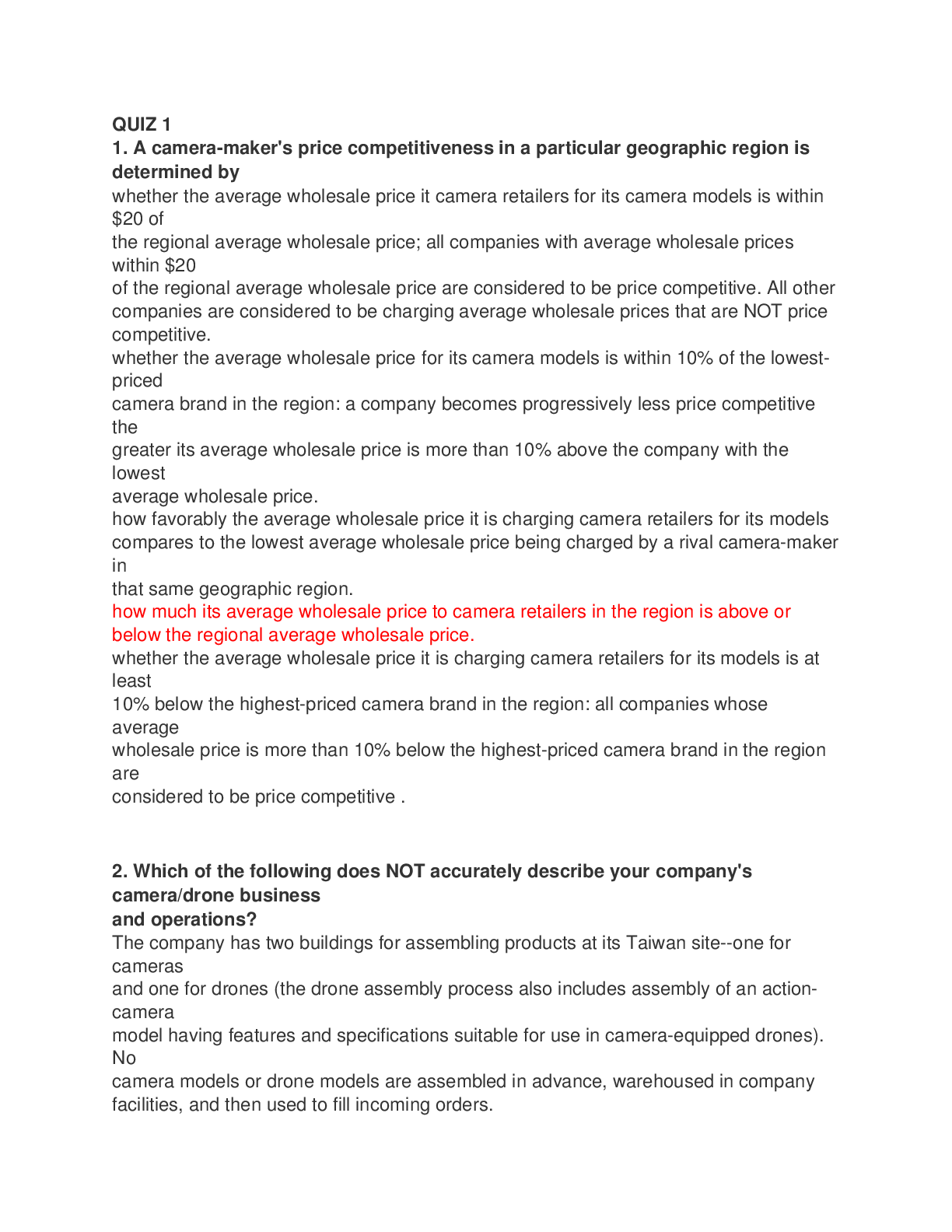
Reviews( 0 )
Document information
Connected school, study & course
About the document
Uploaded On
Oct 31, 2020
Number of pages
38
Written in
Additional information
This document has been written for:
Uploaded
Oct 31, 2020
Downloads
0
Views
65

.png)
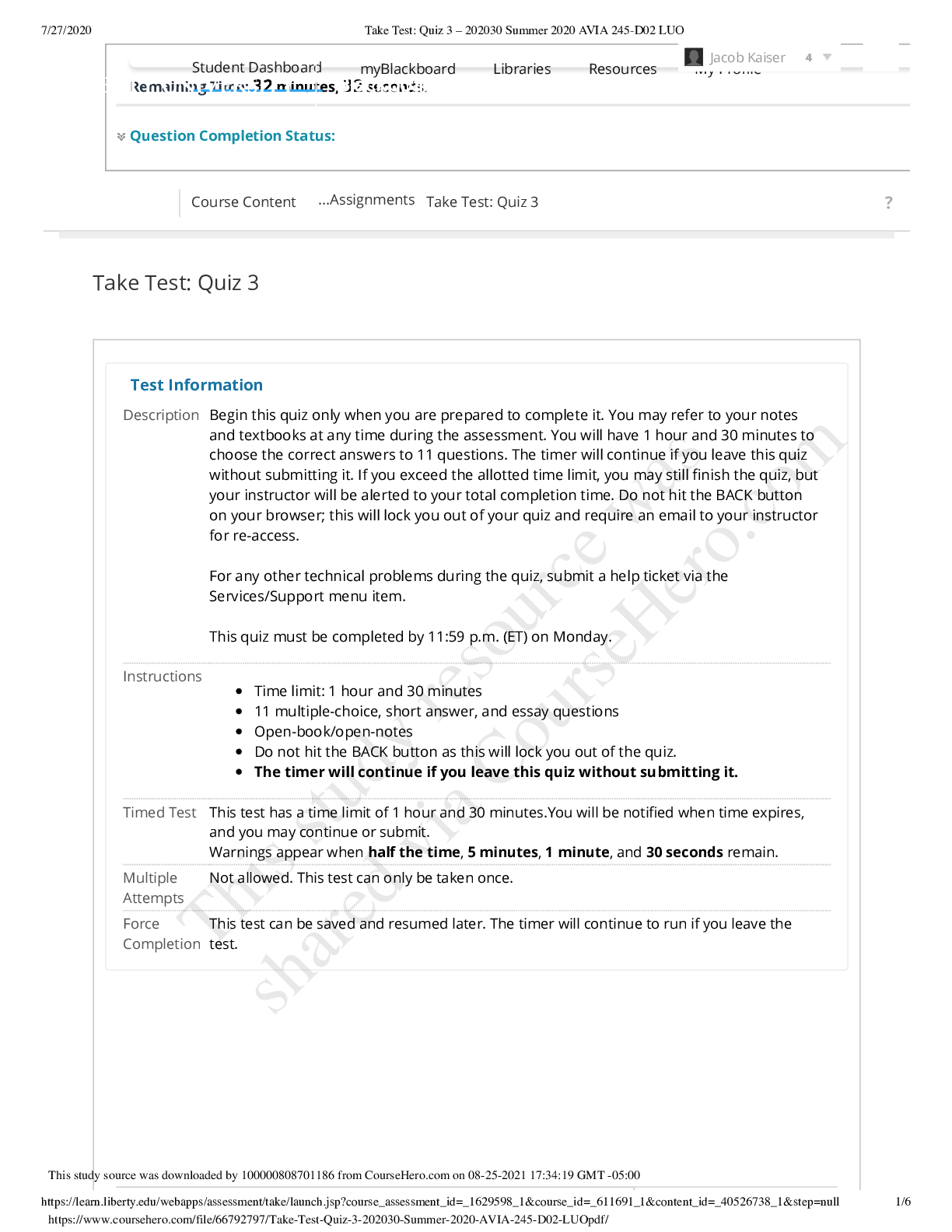
.png)

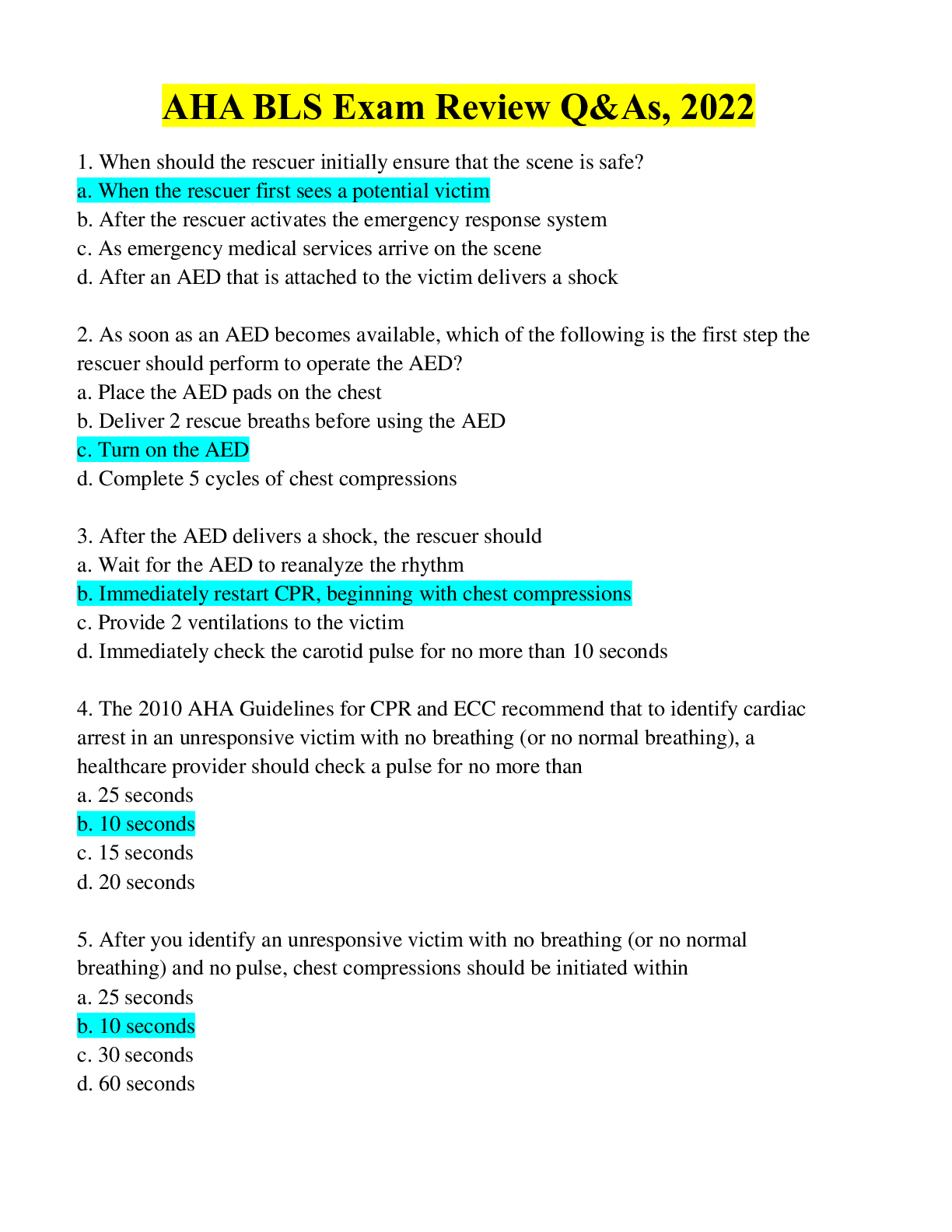
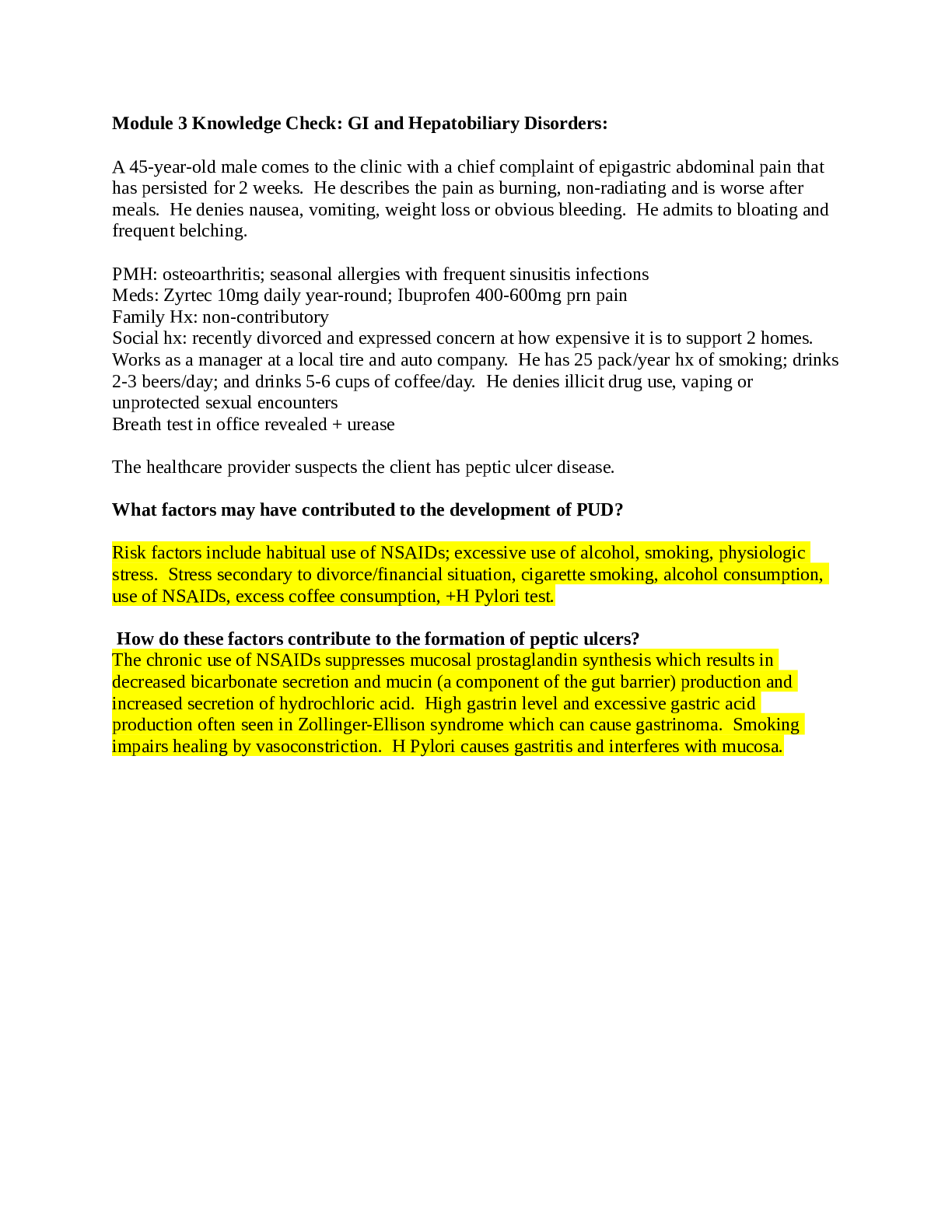
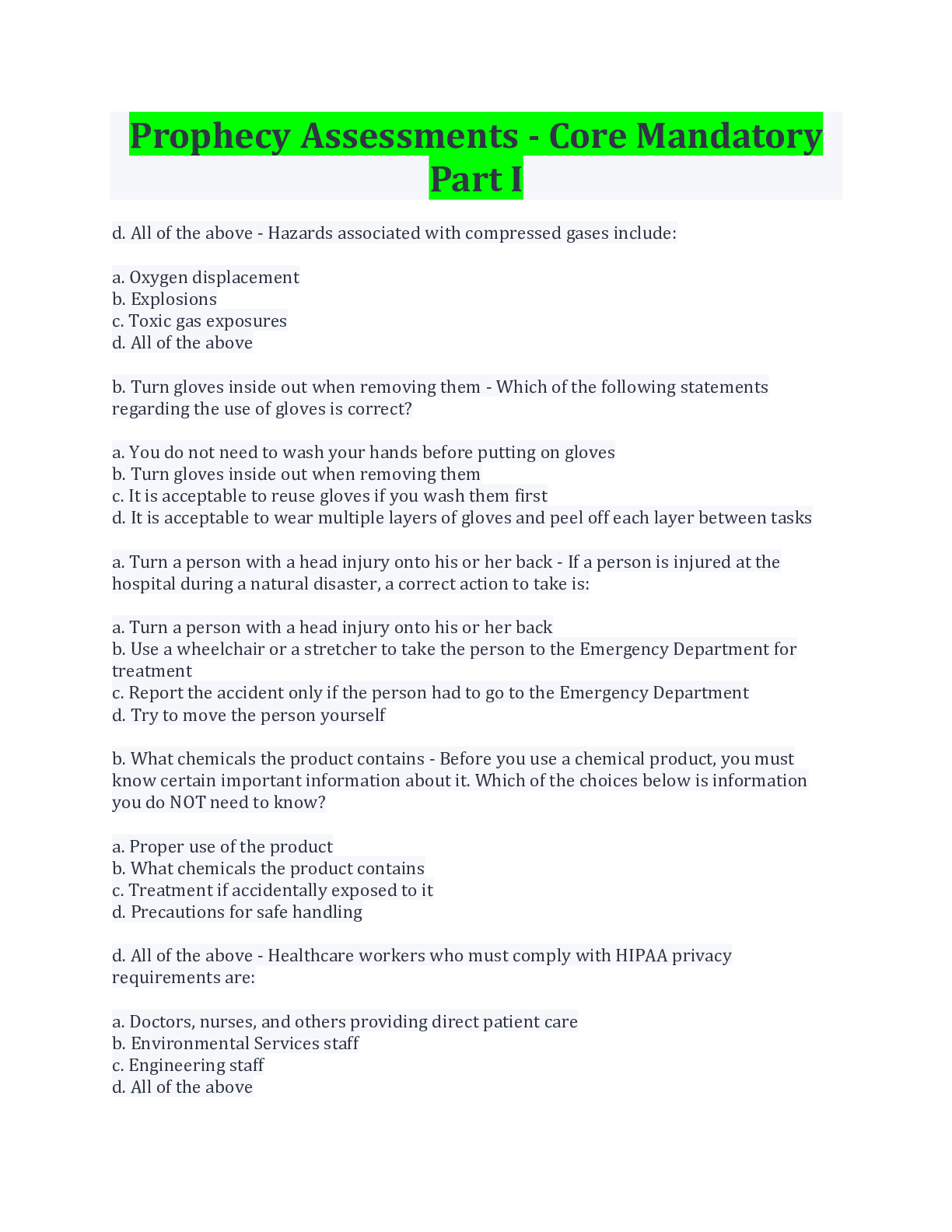

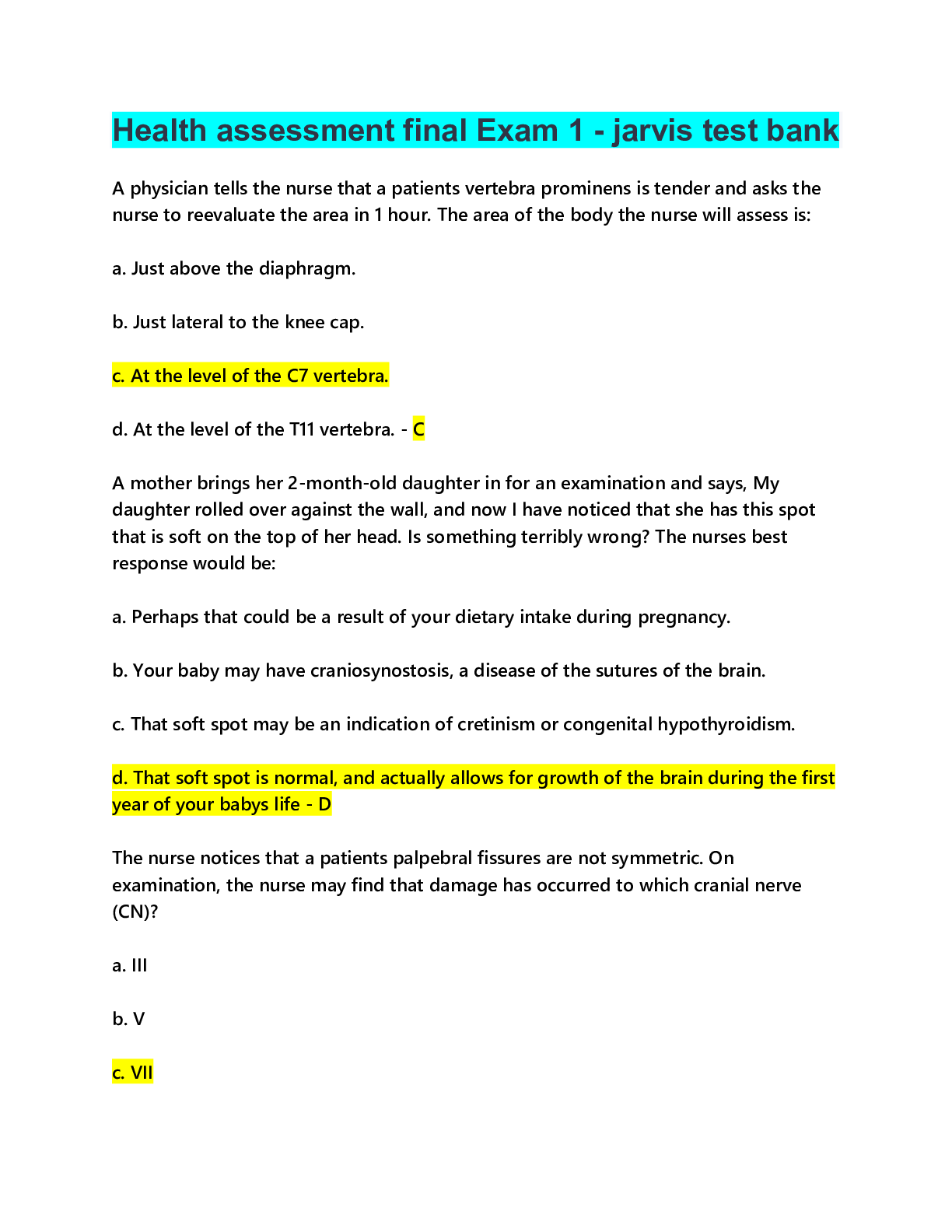


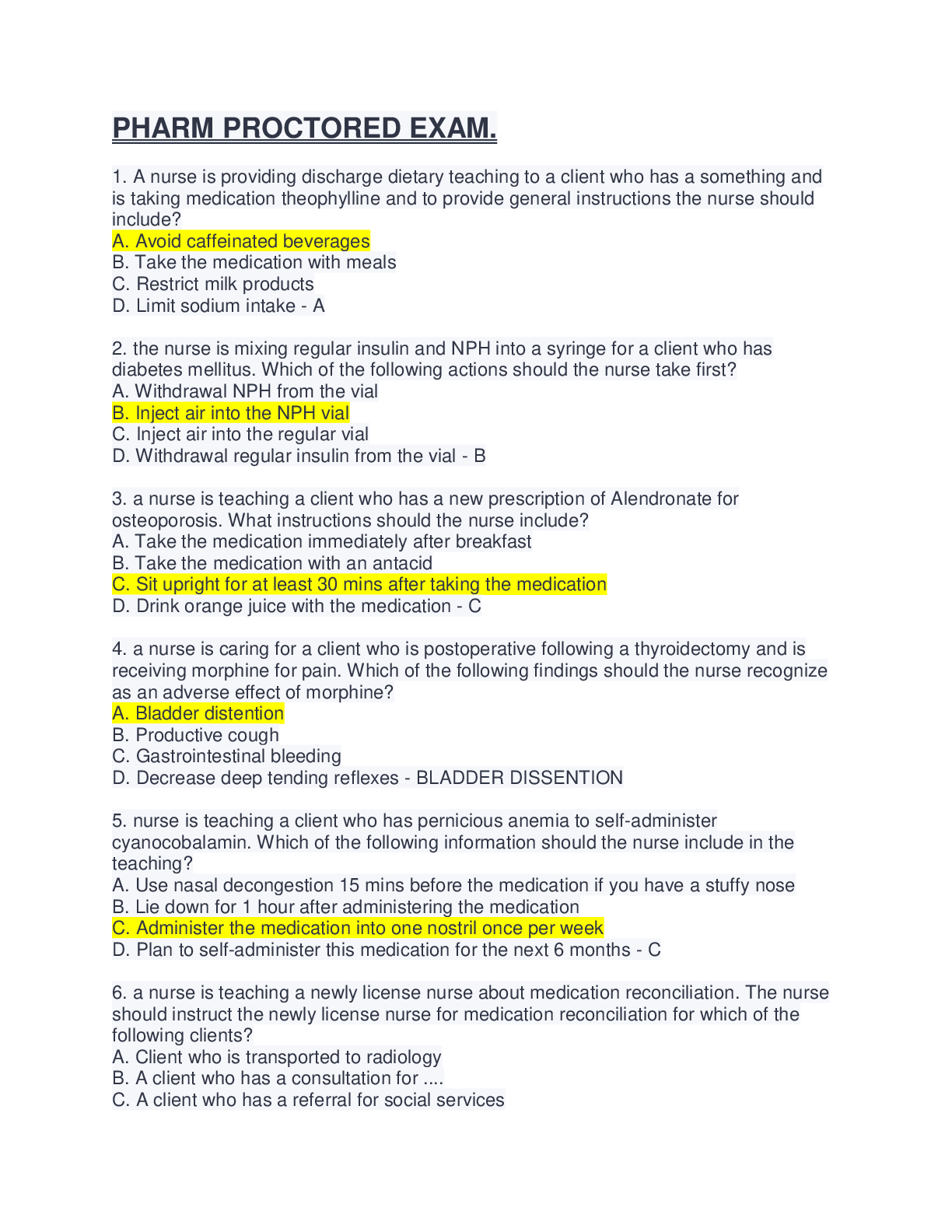



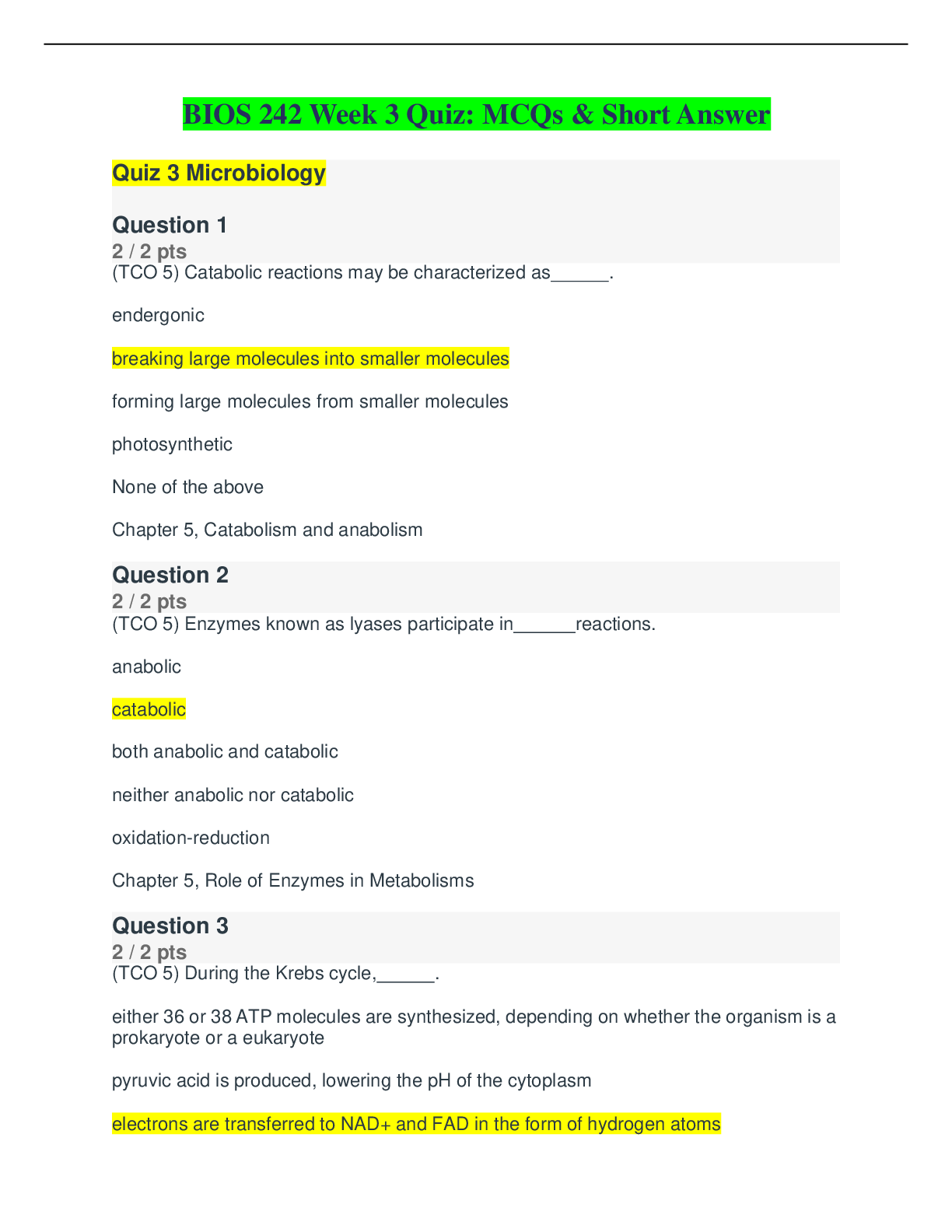

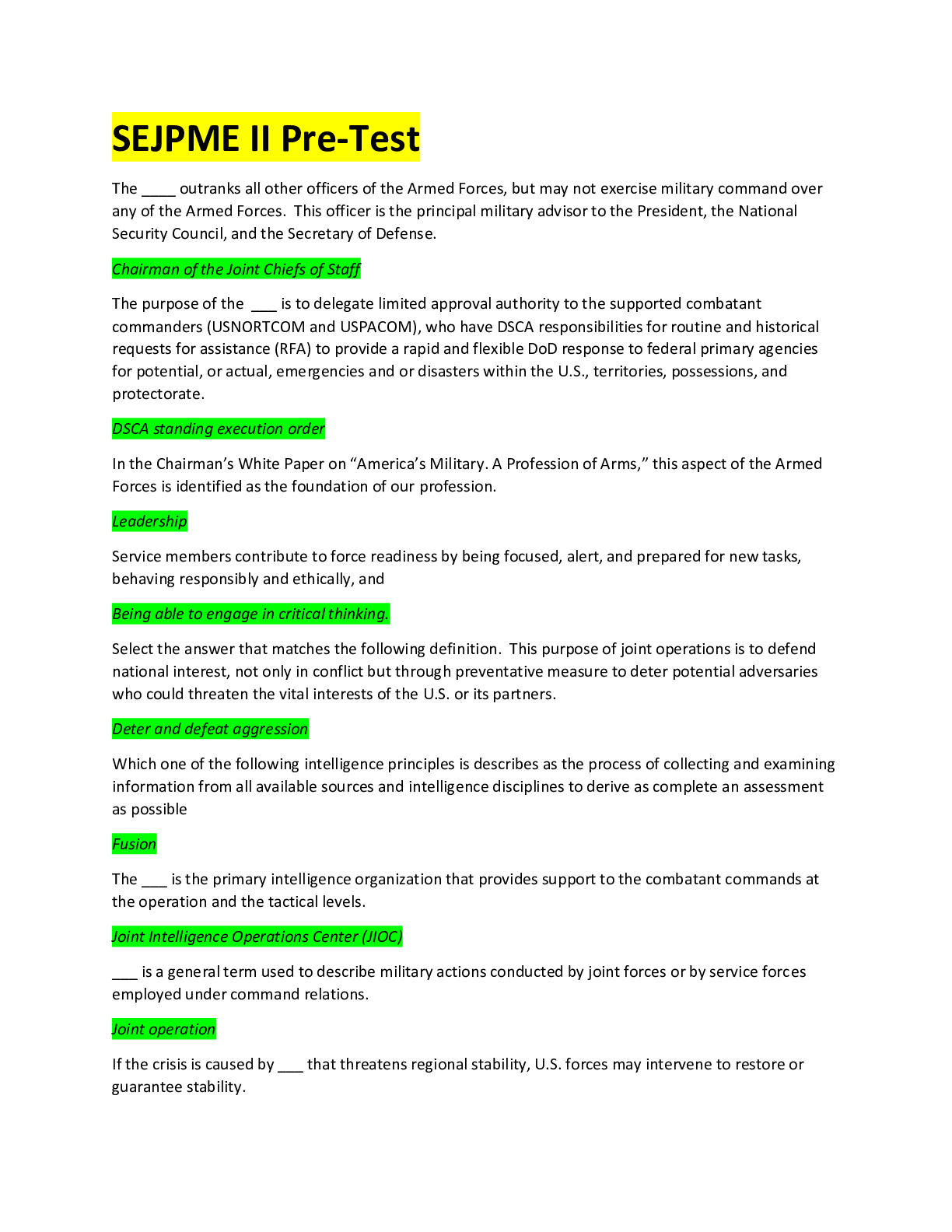
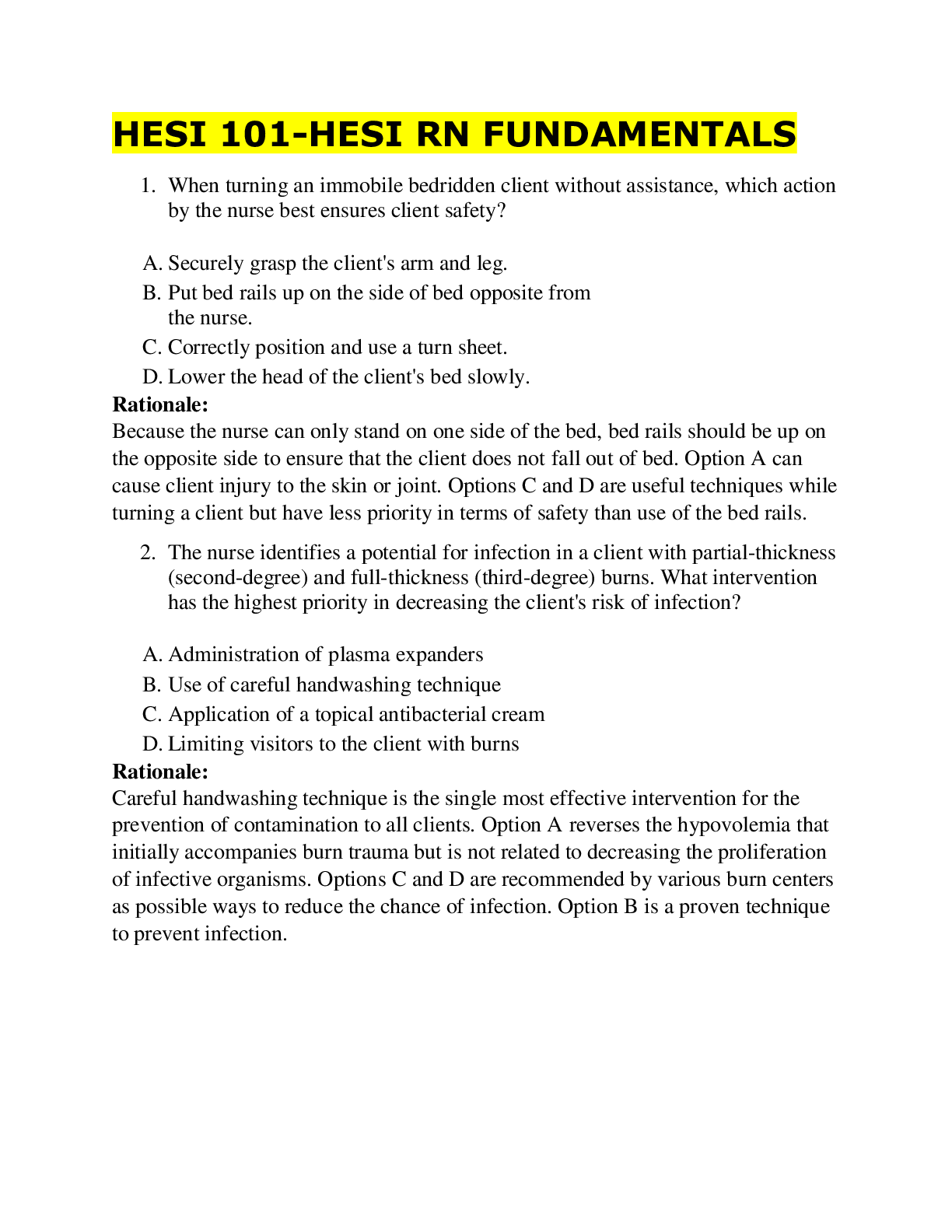



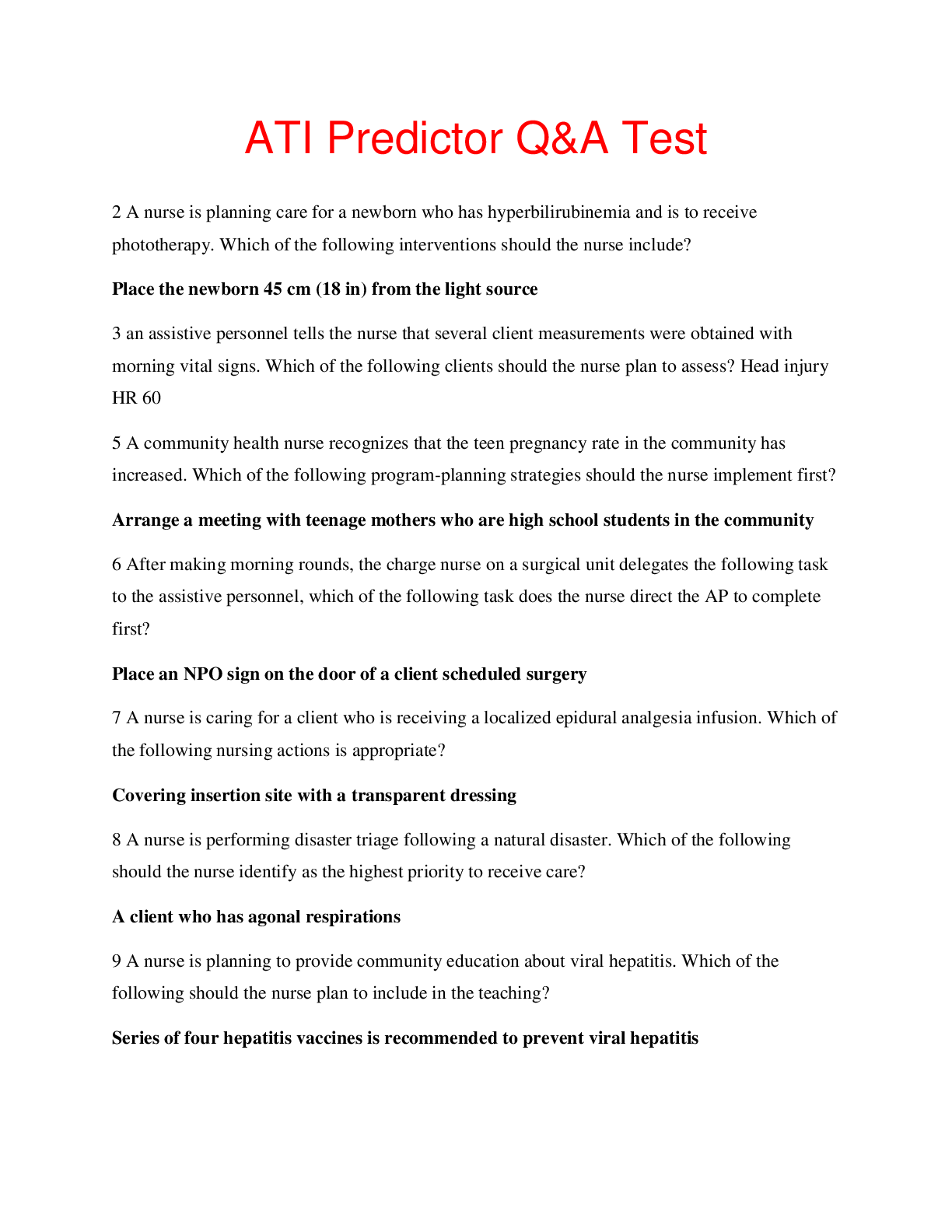
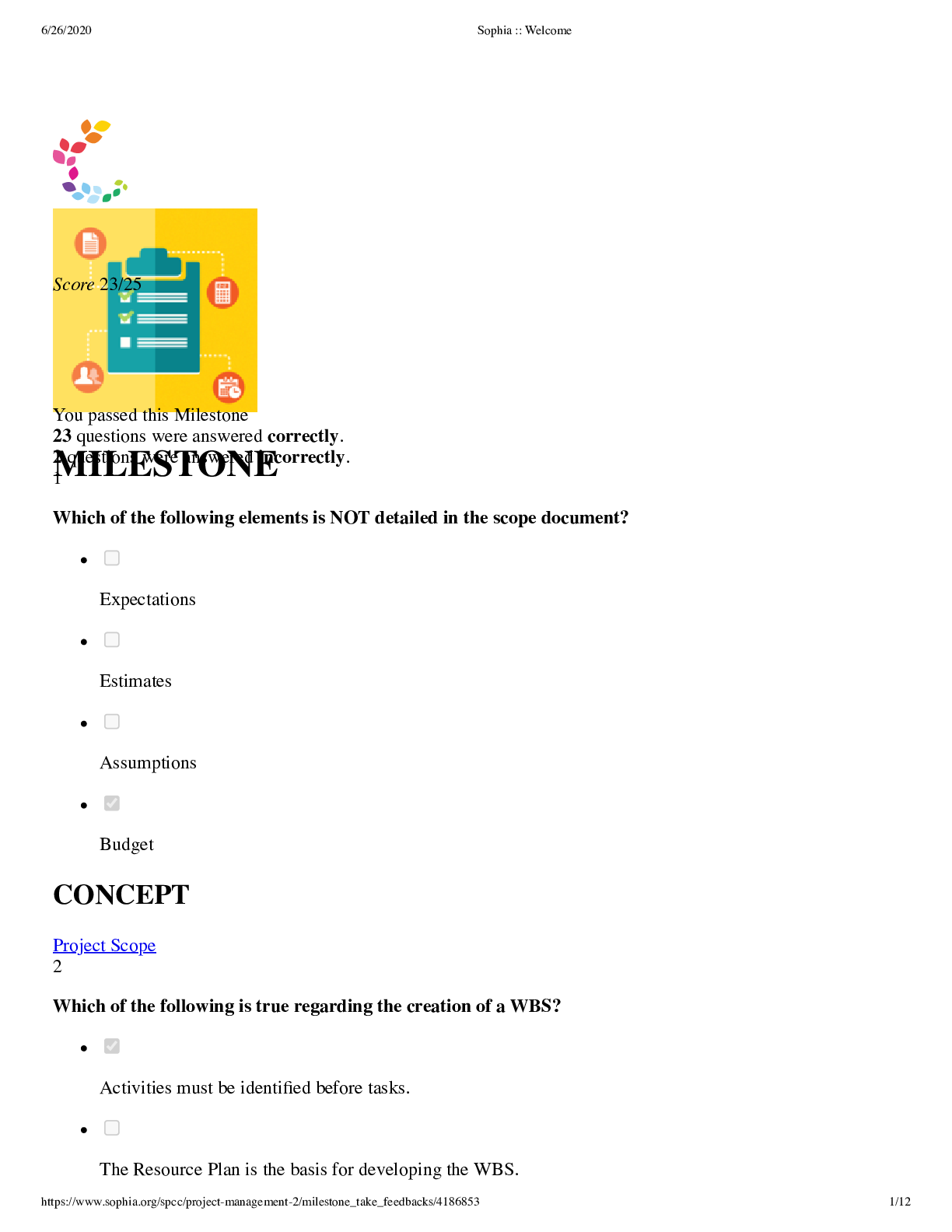
.png)
